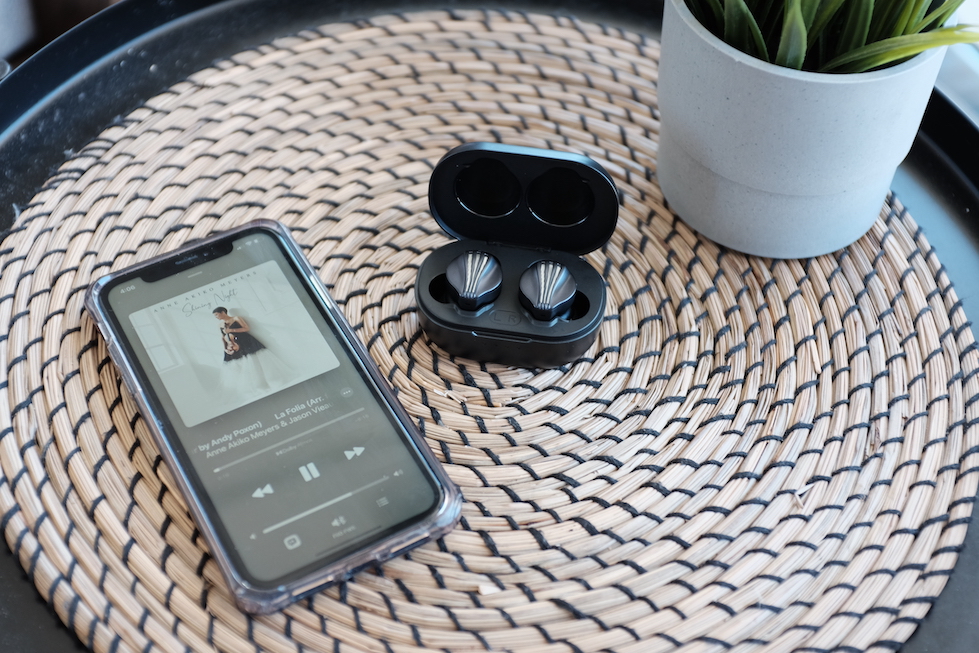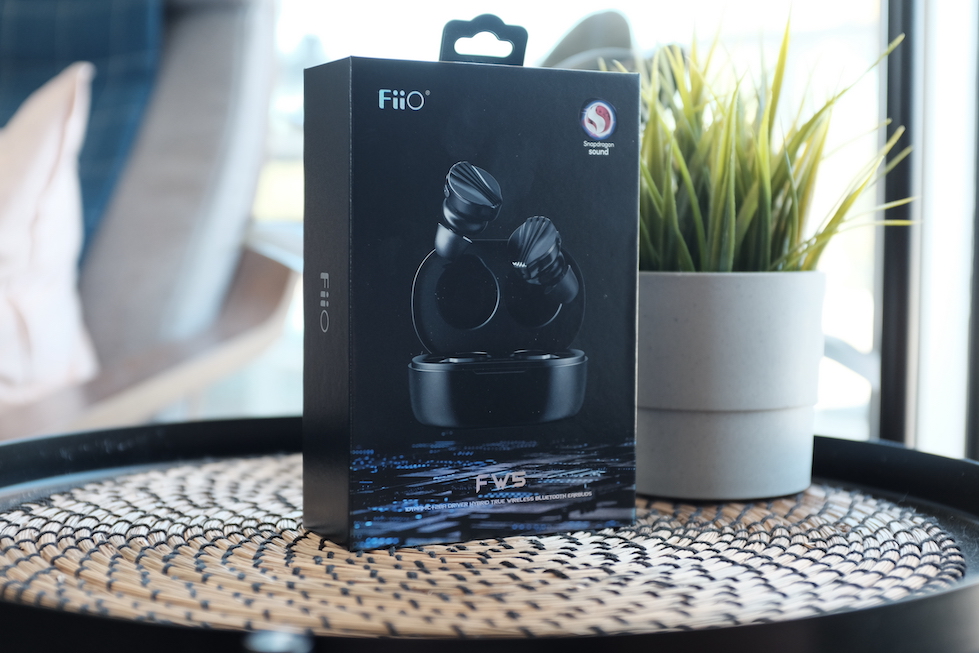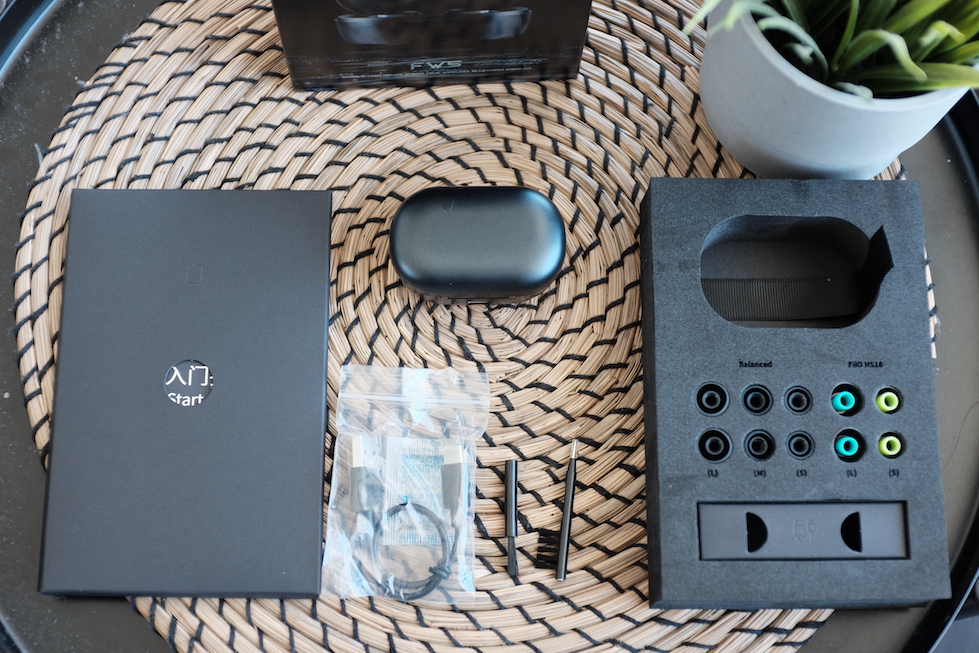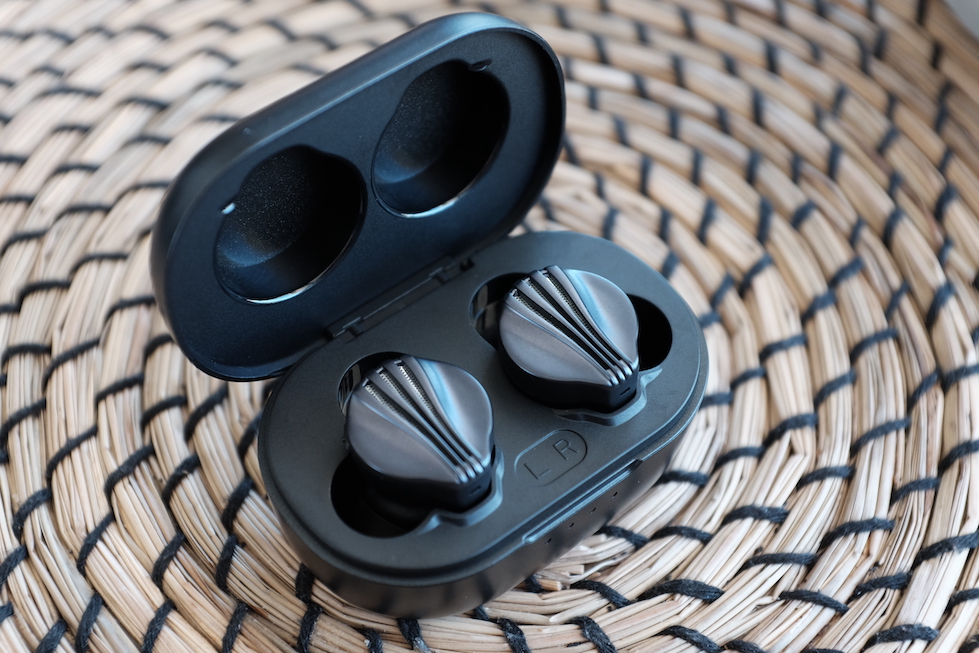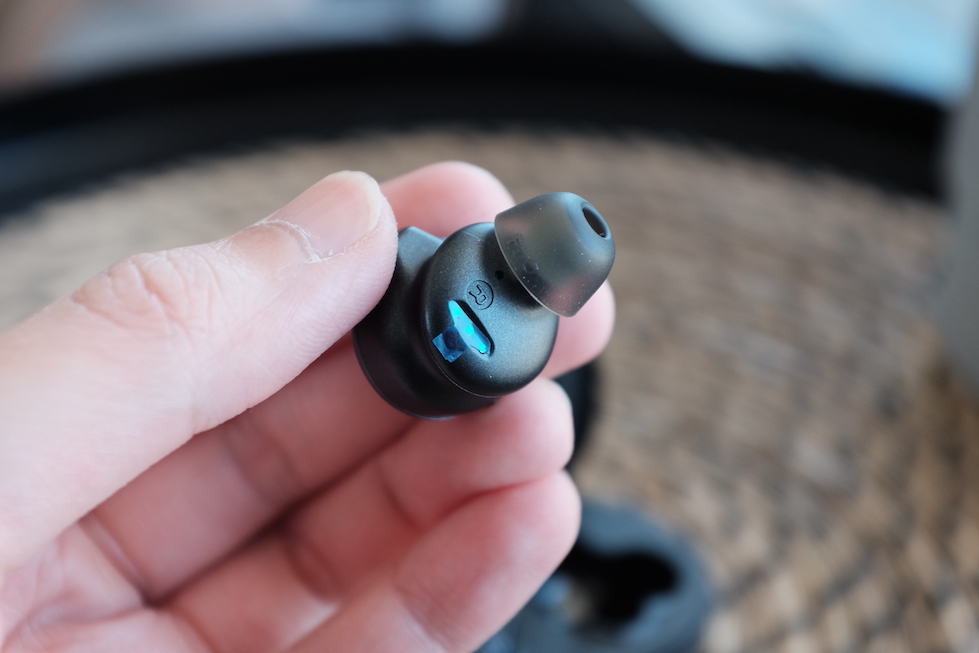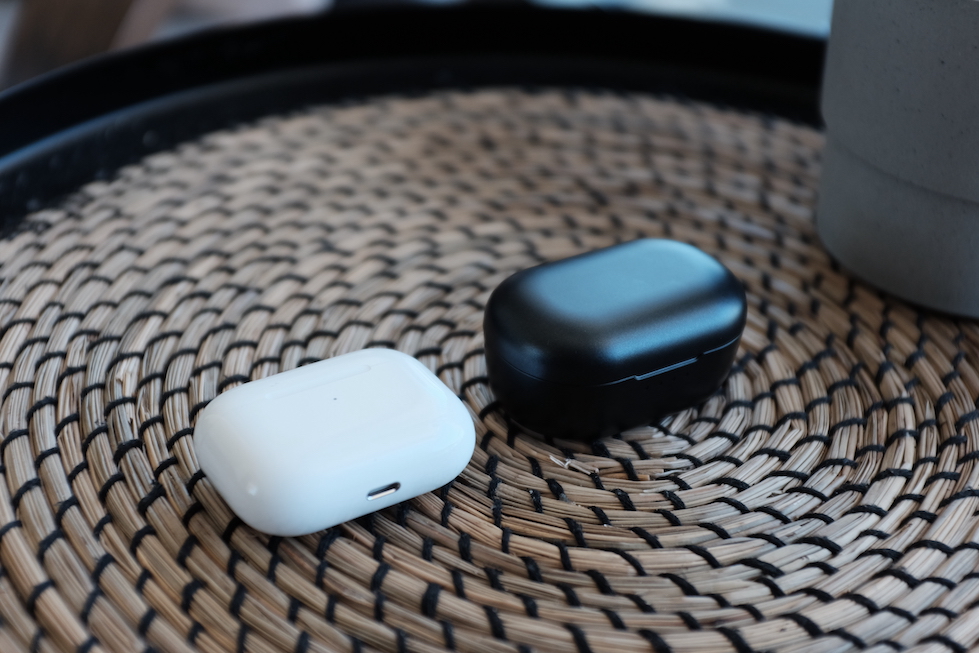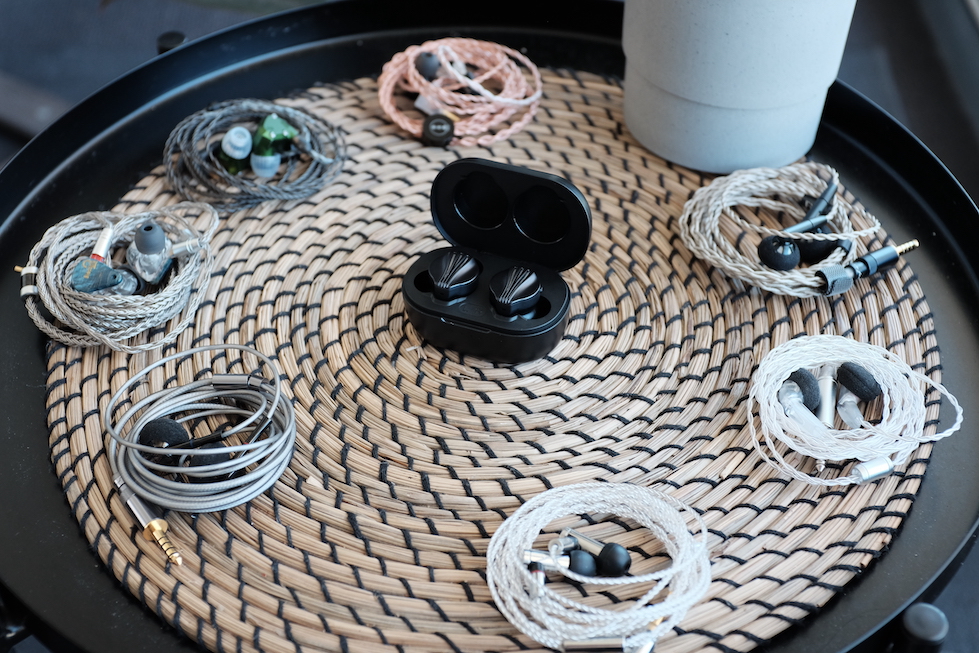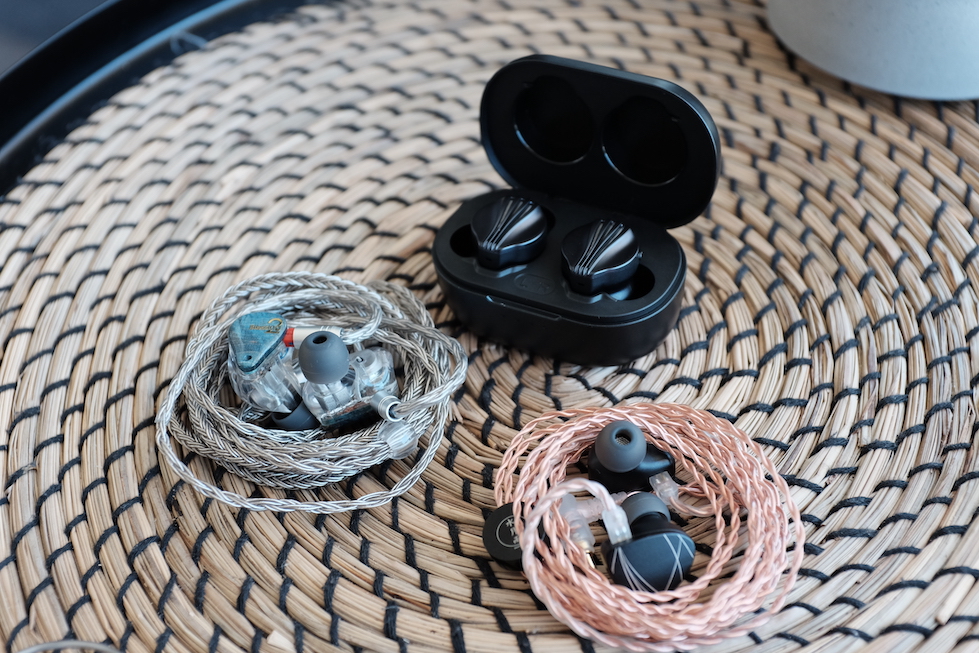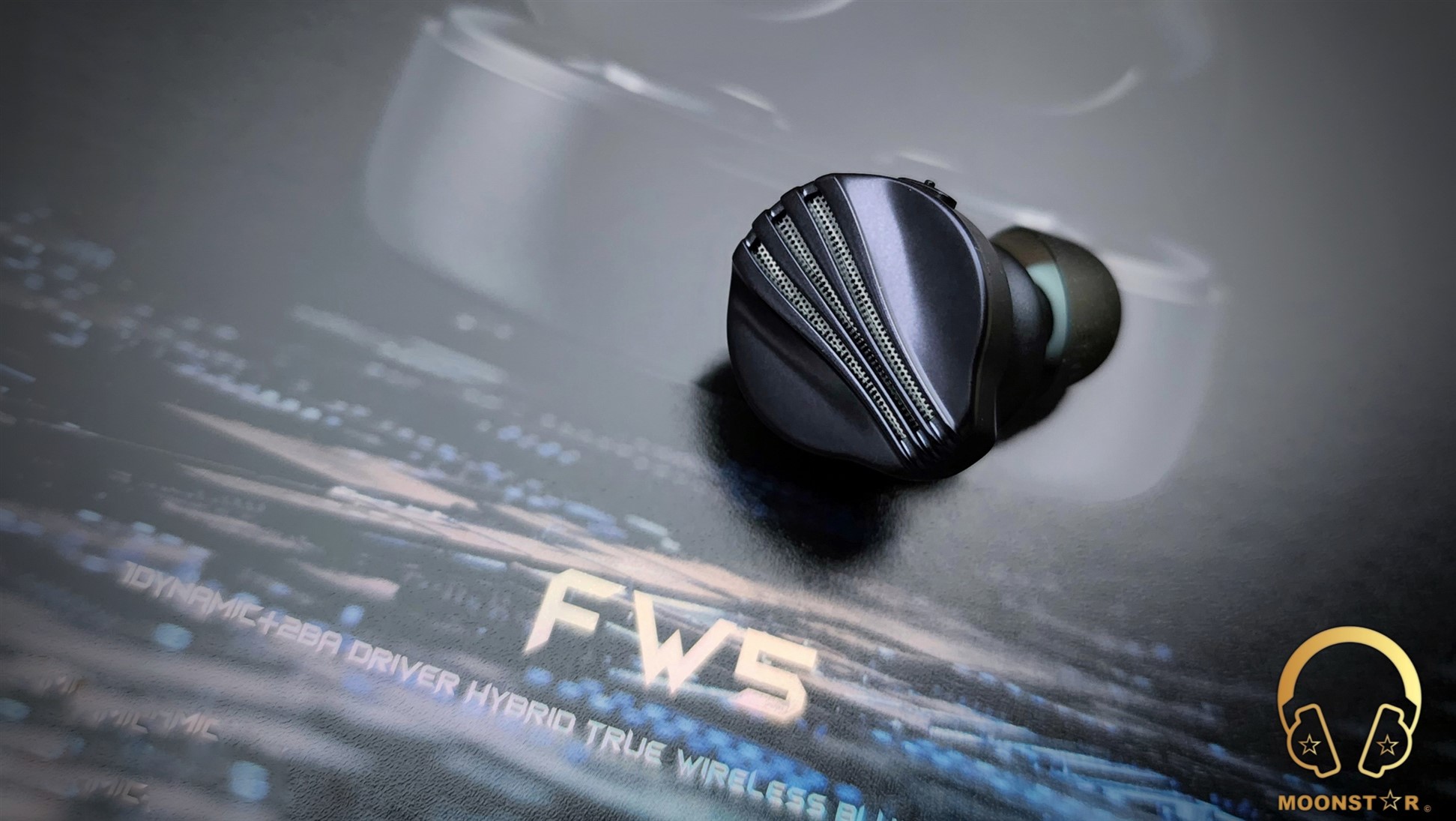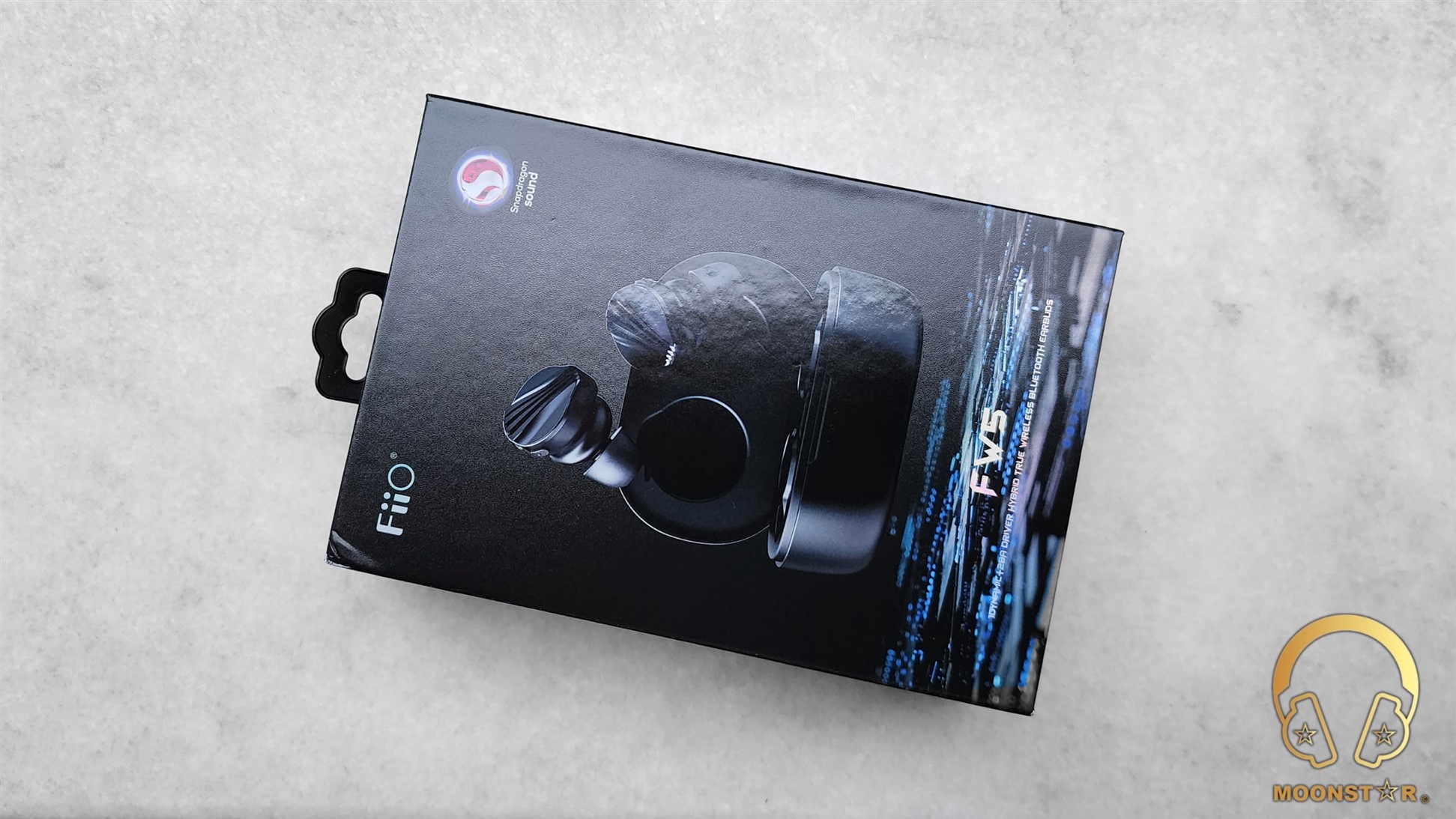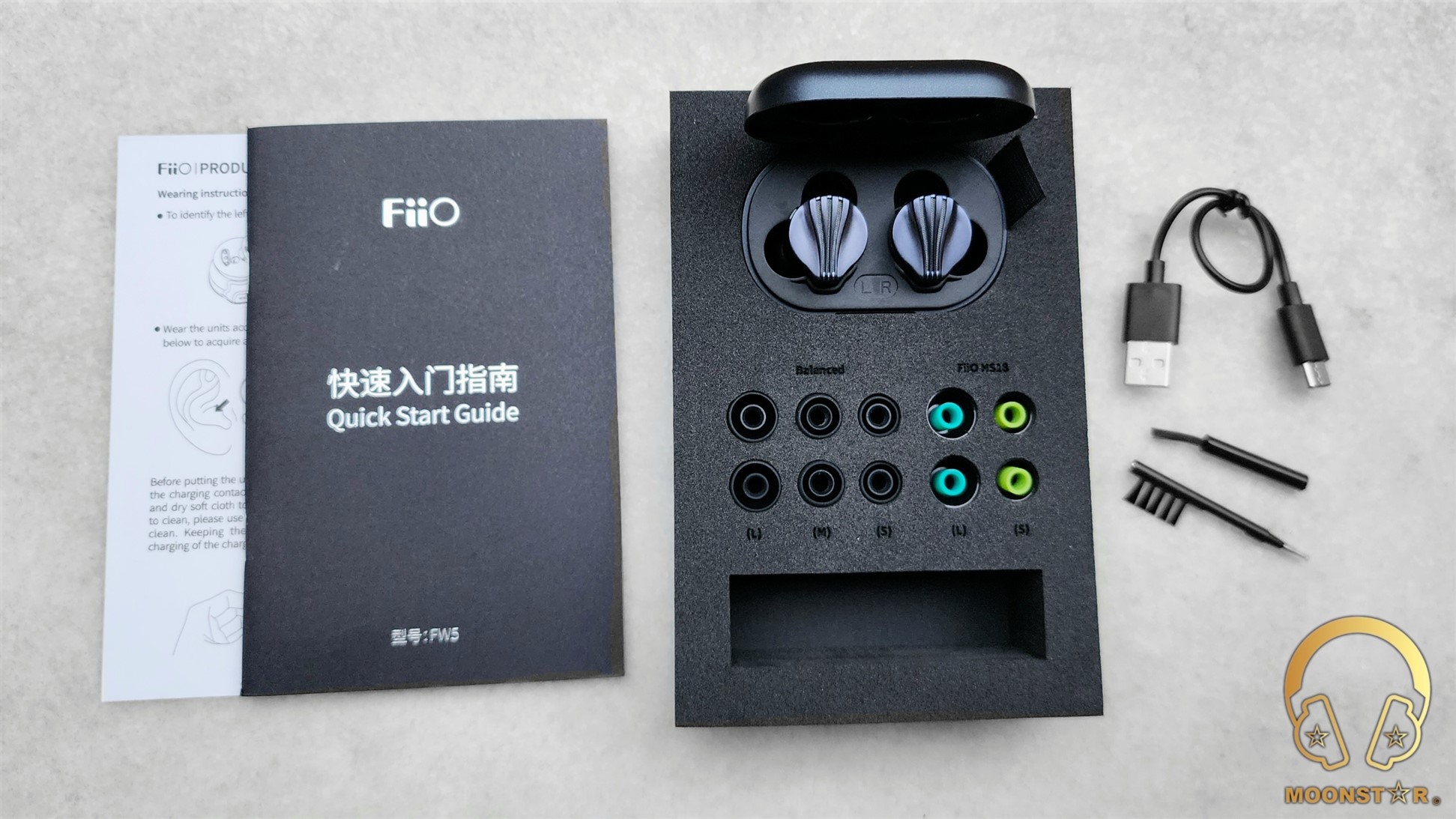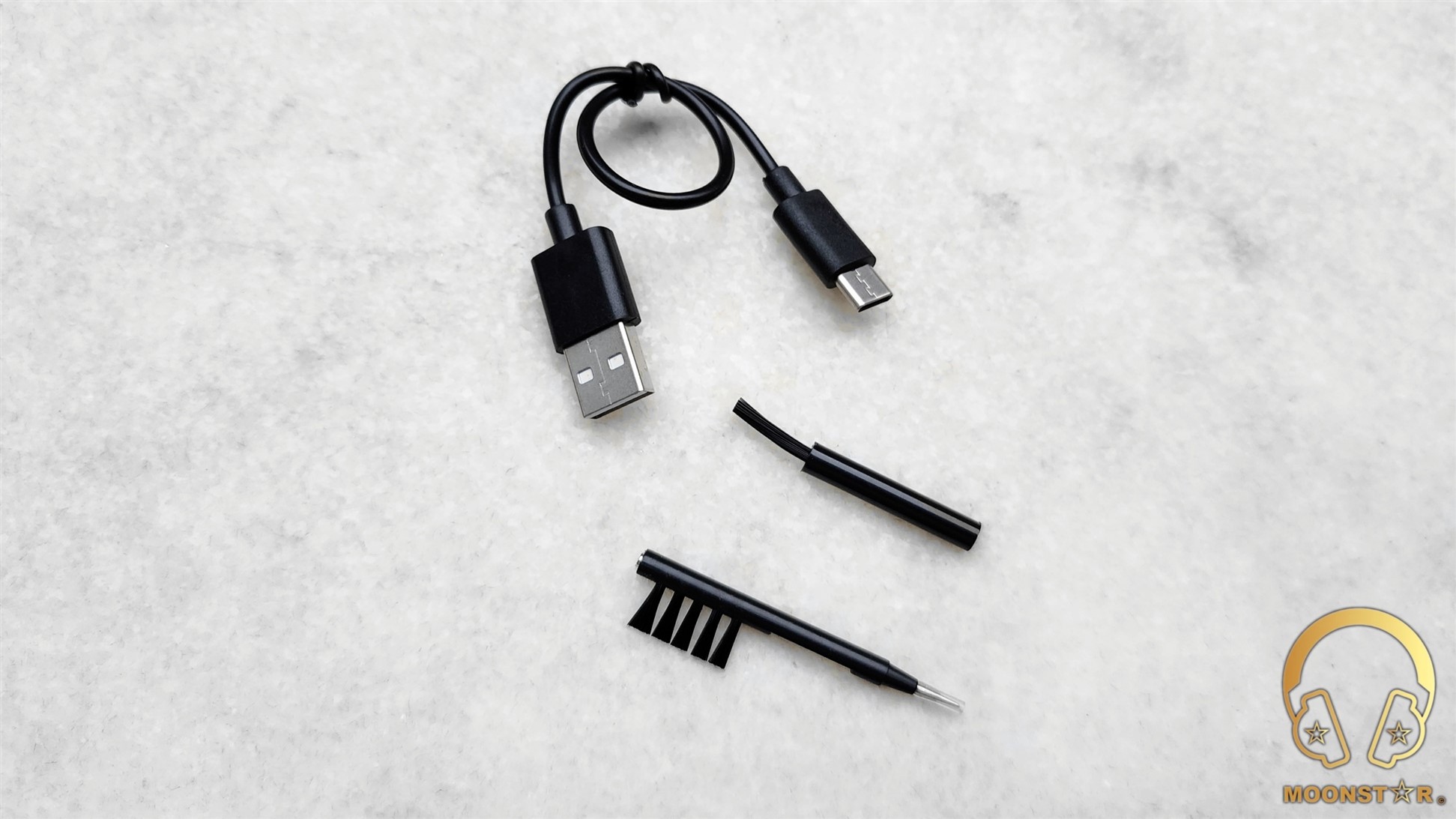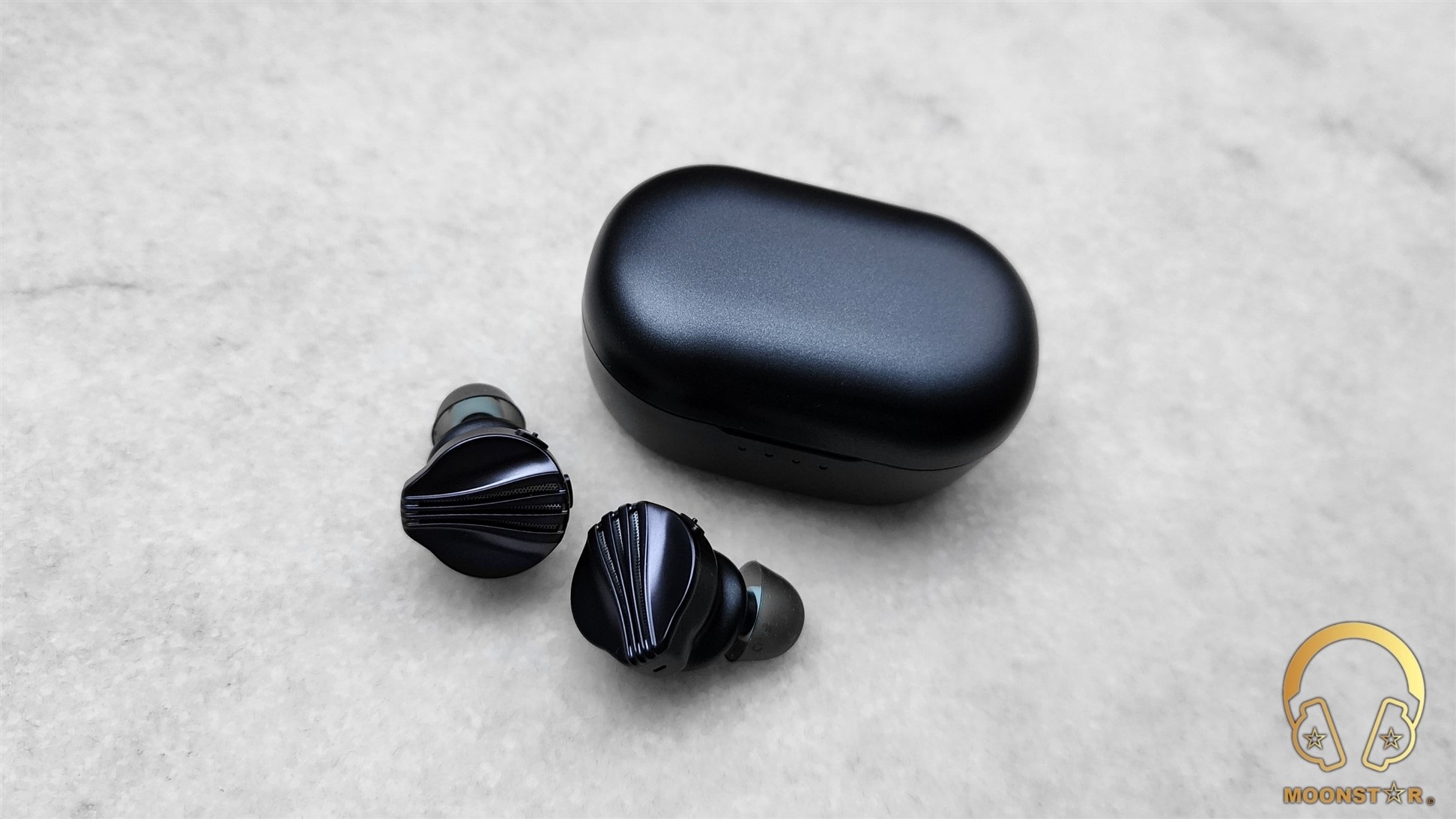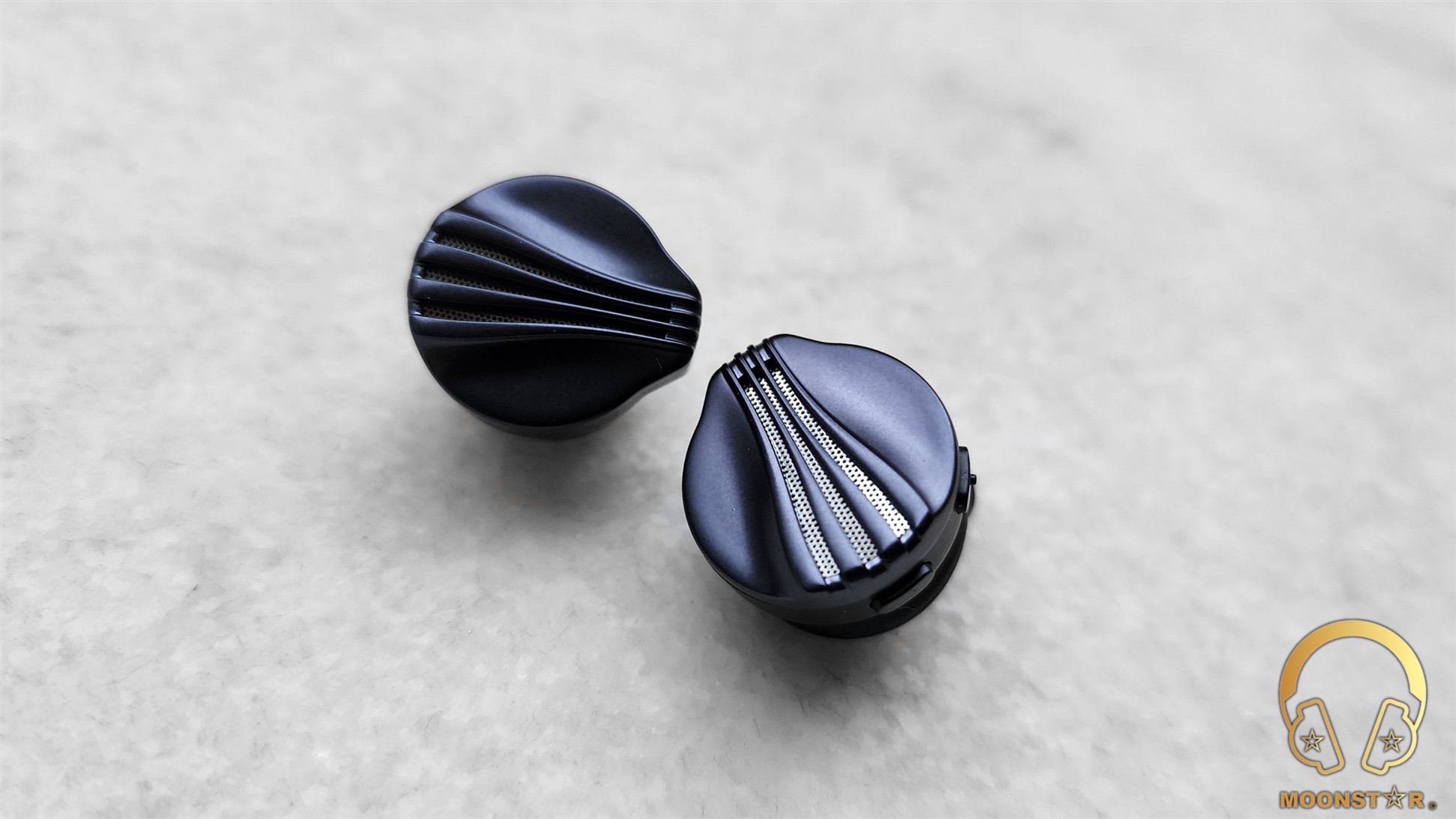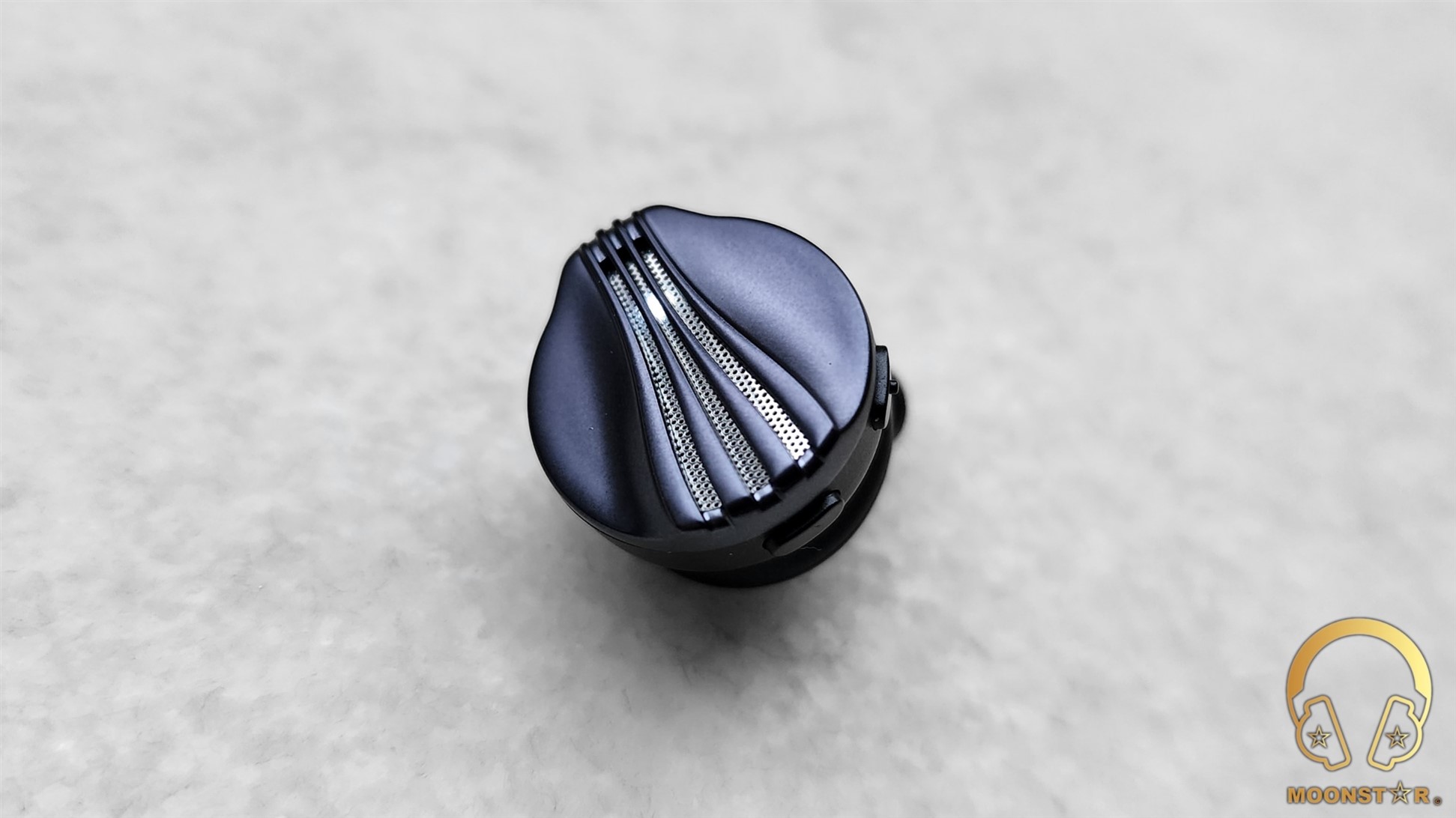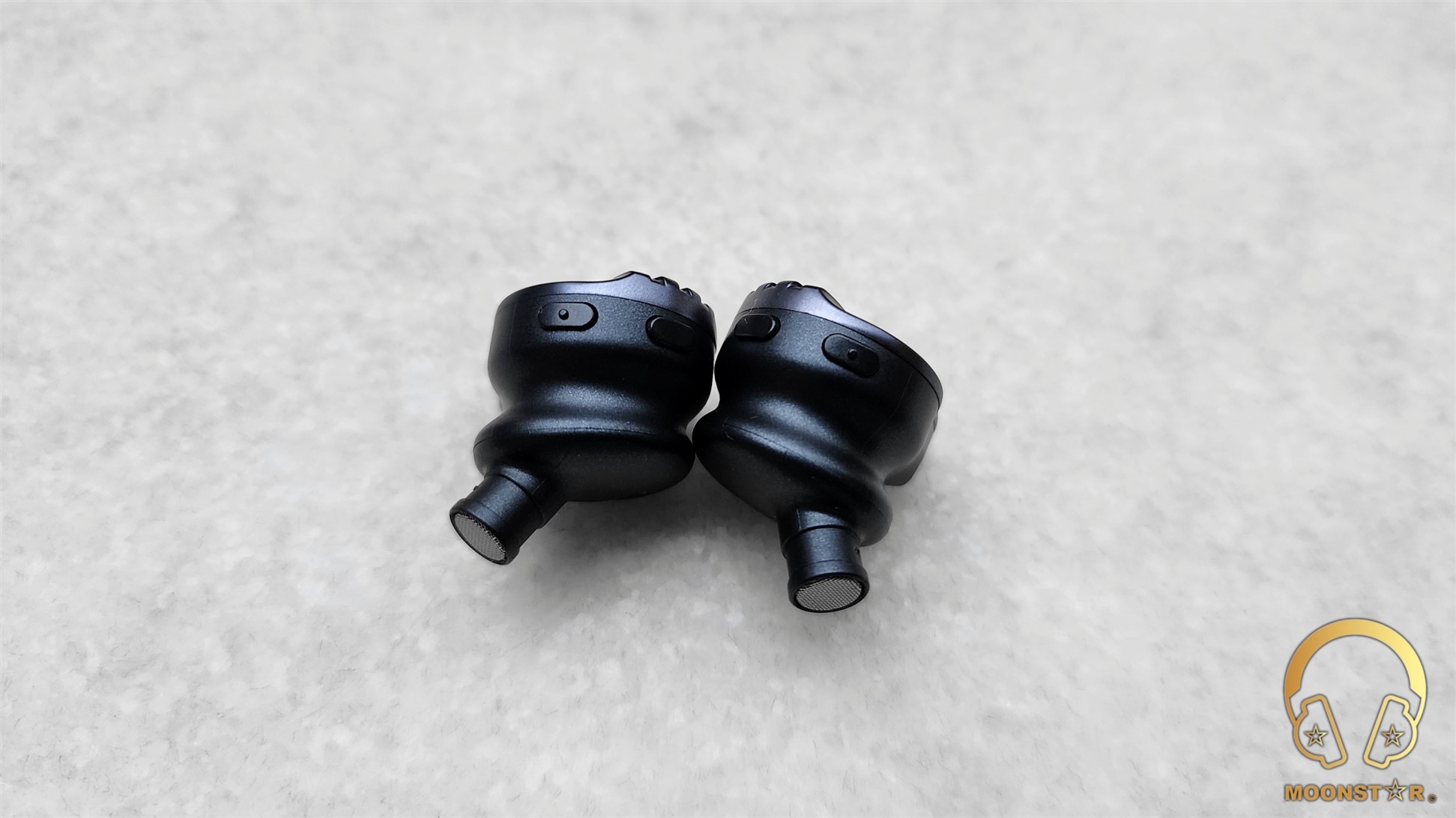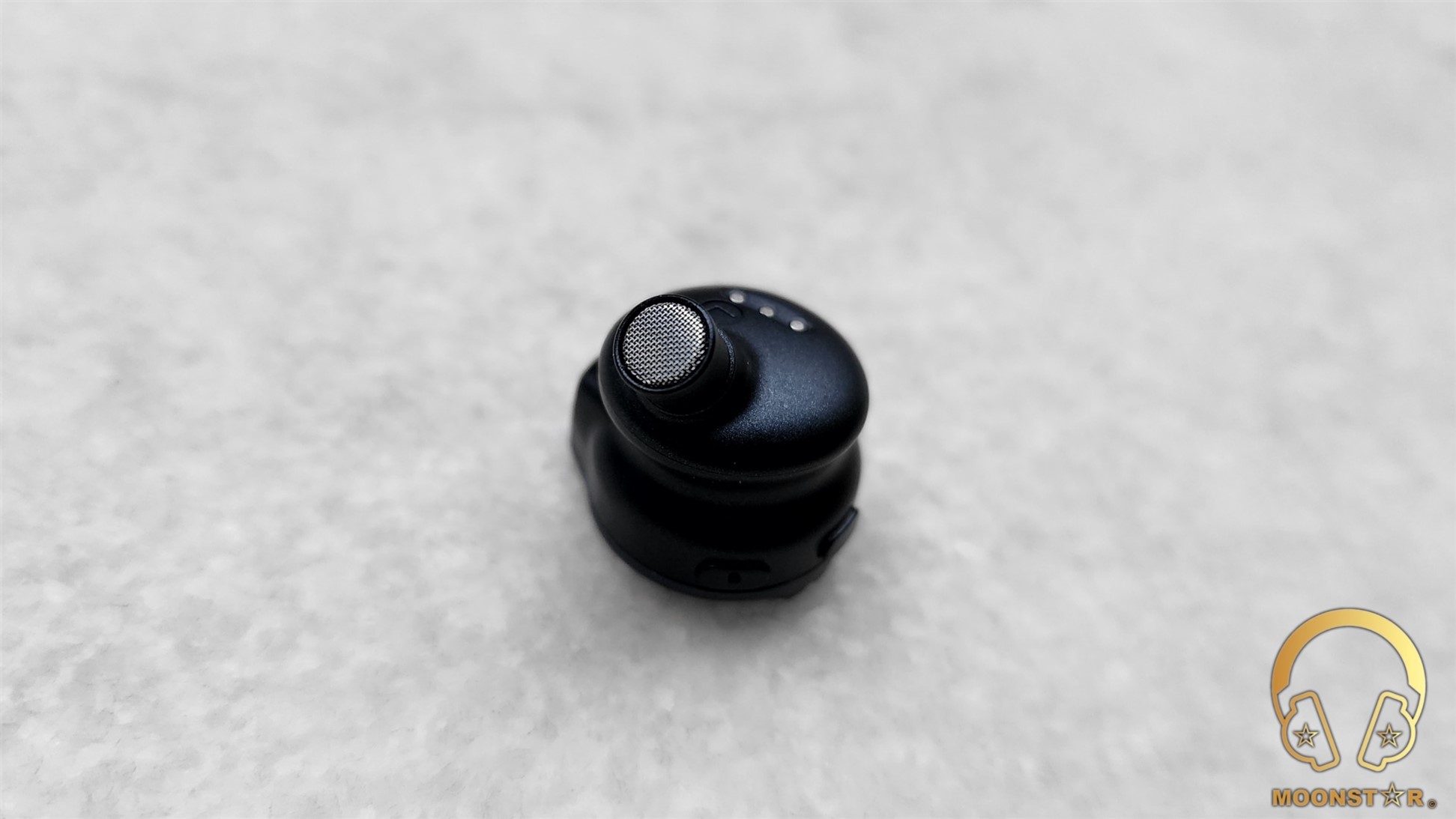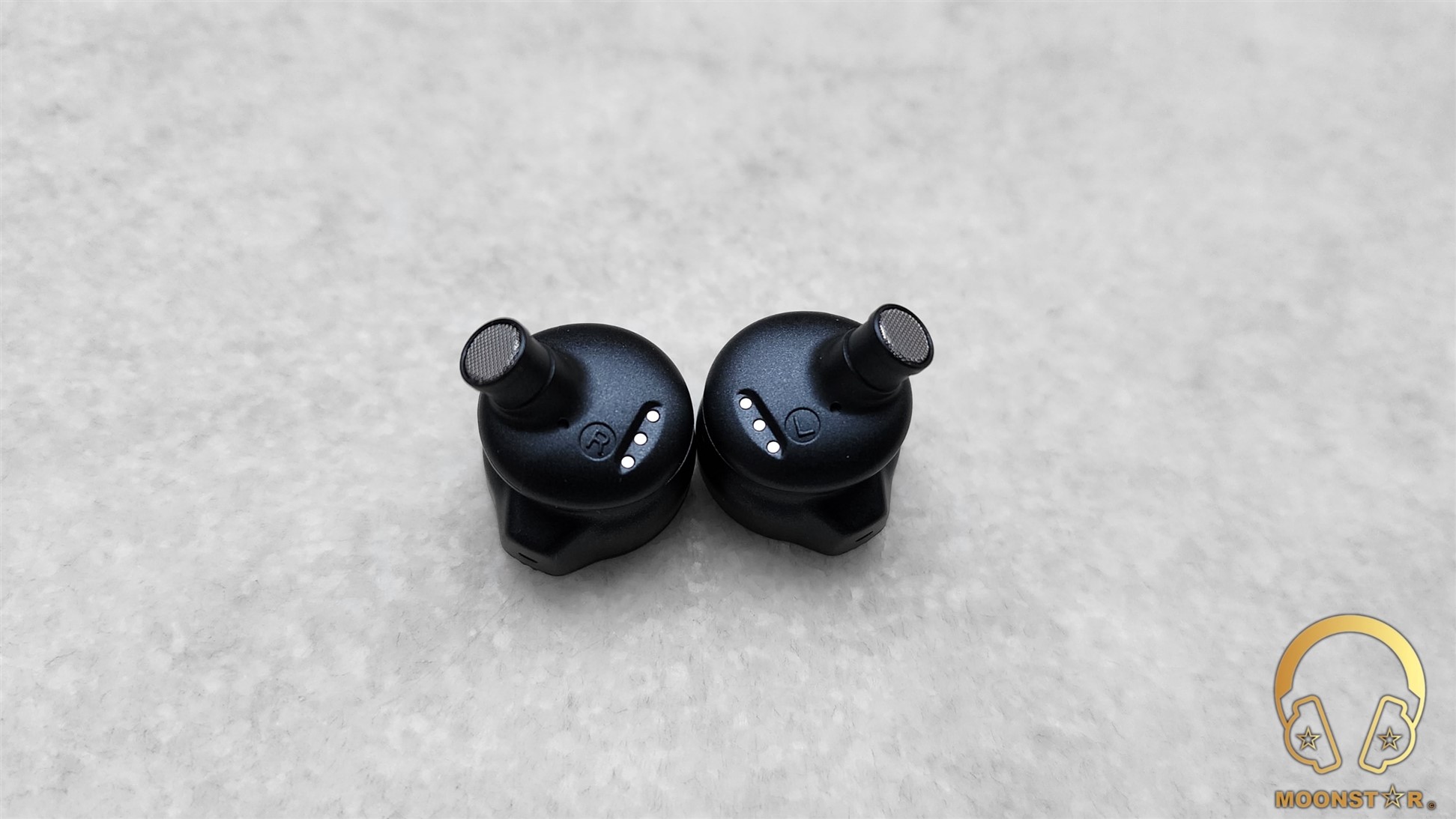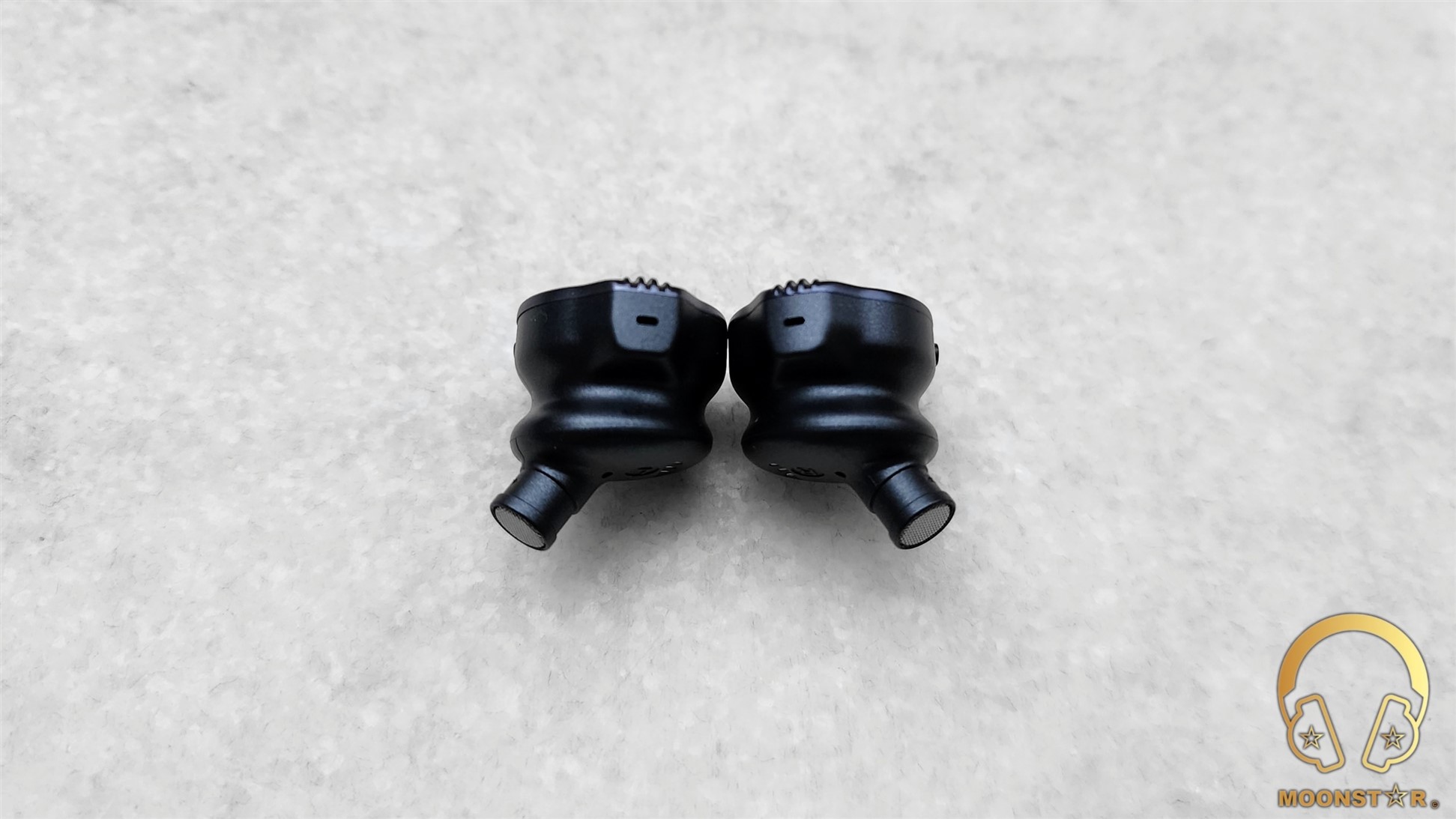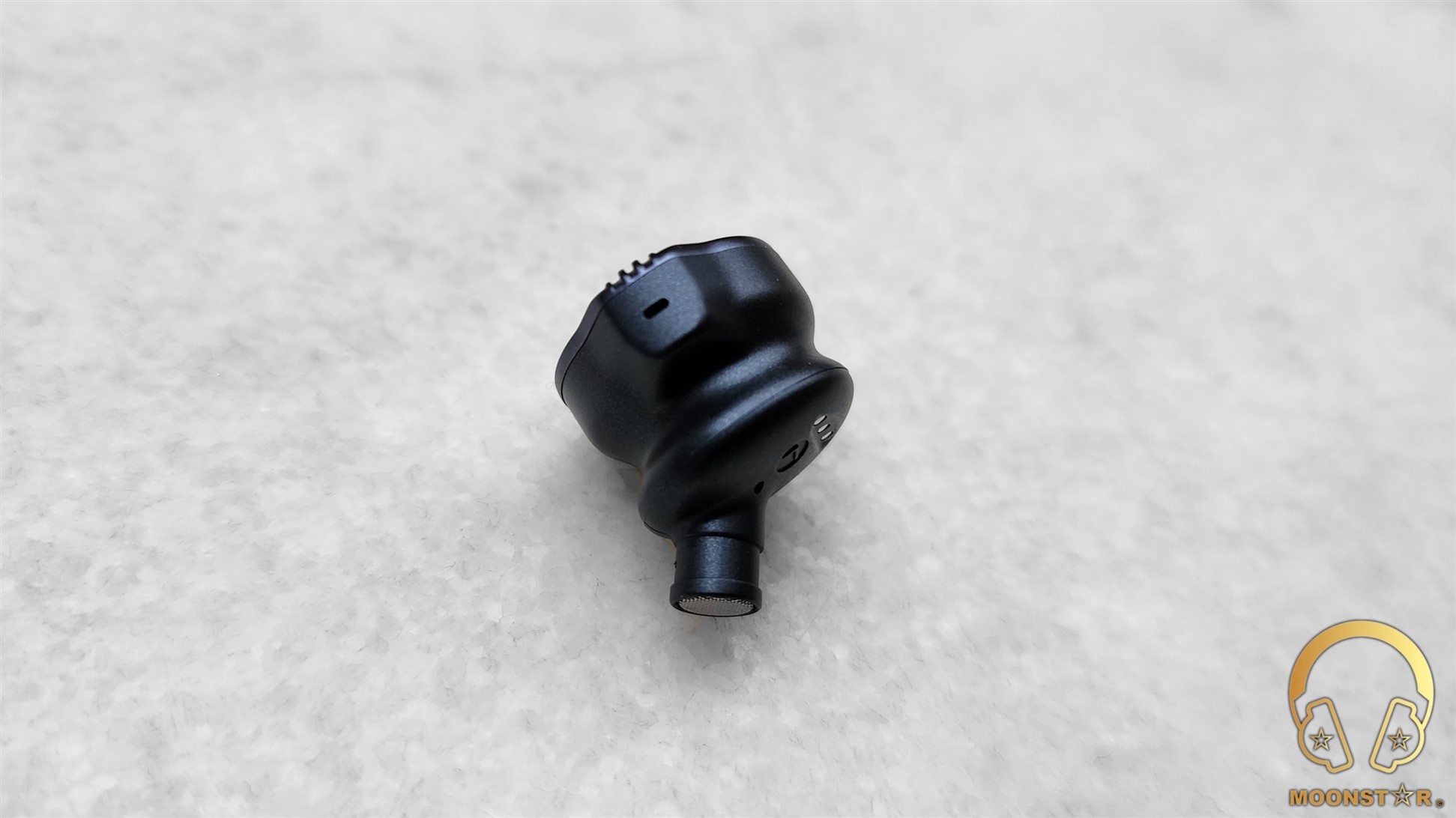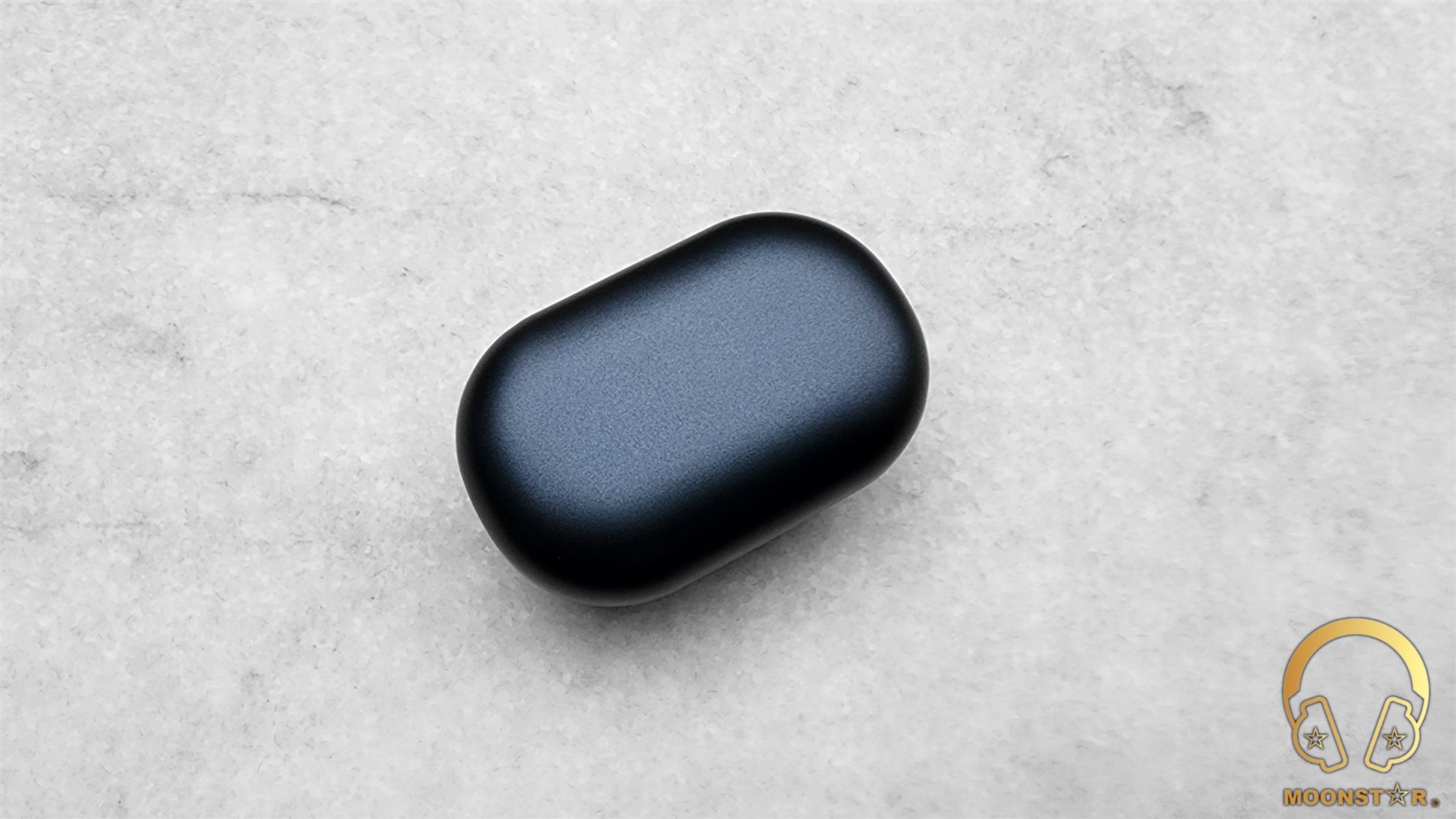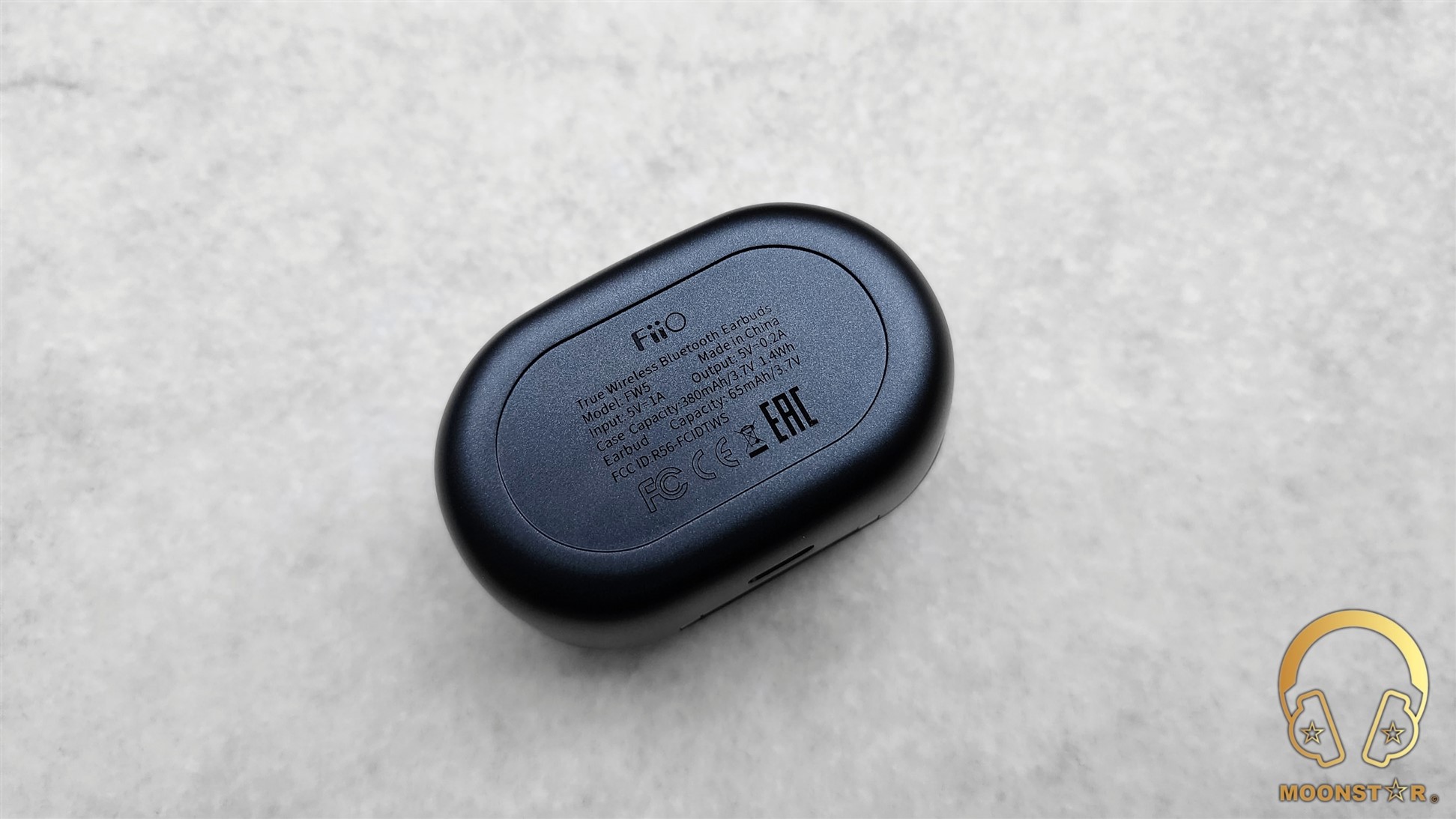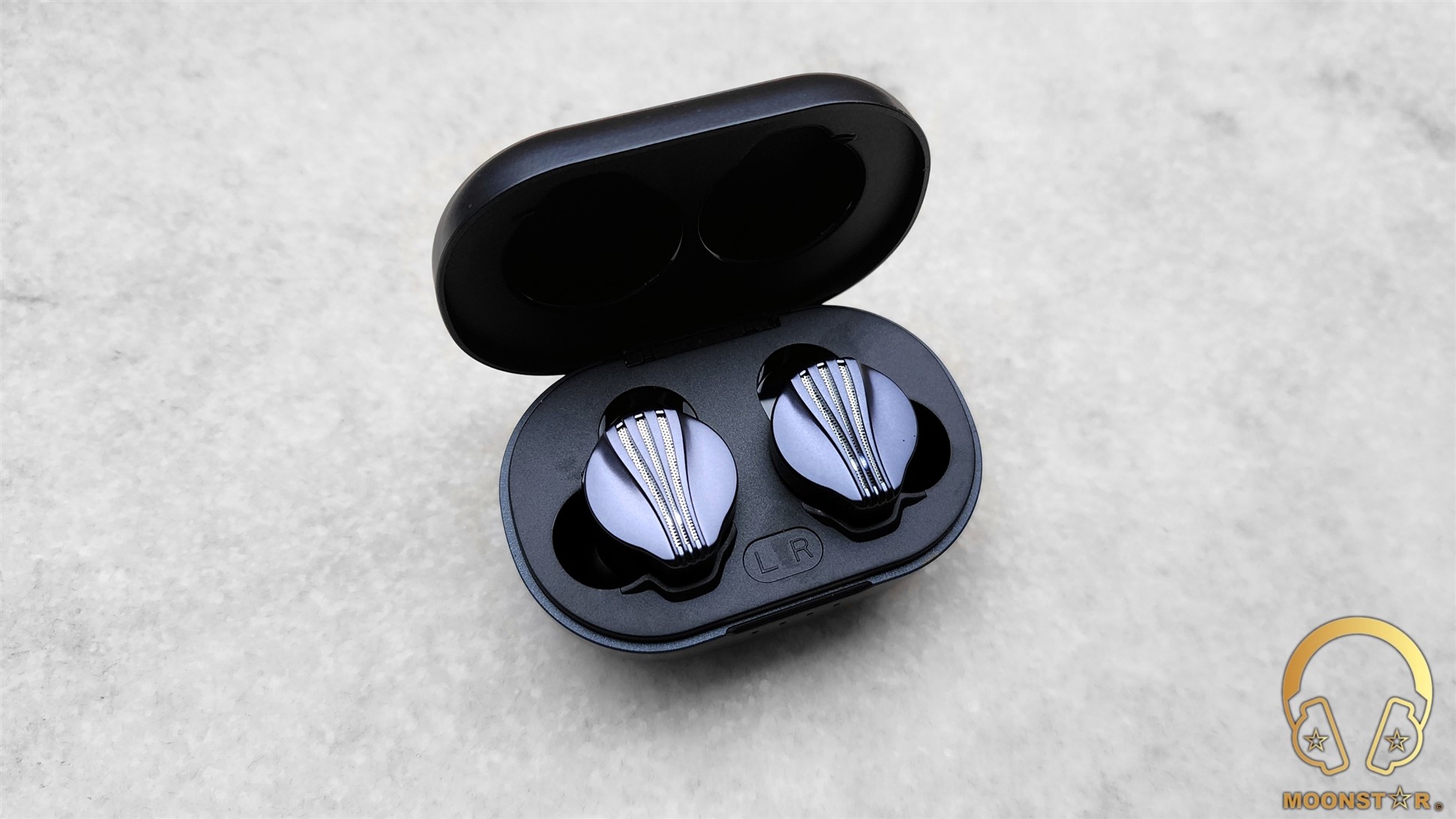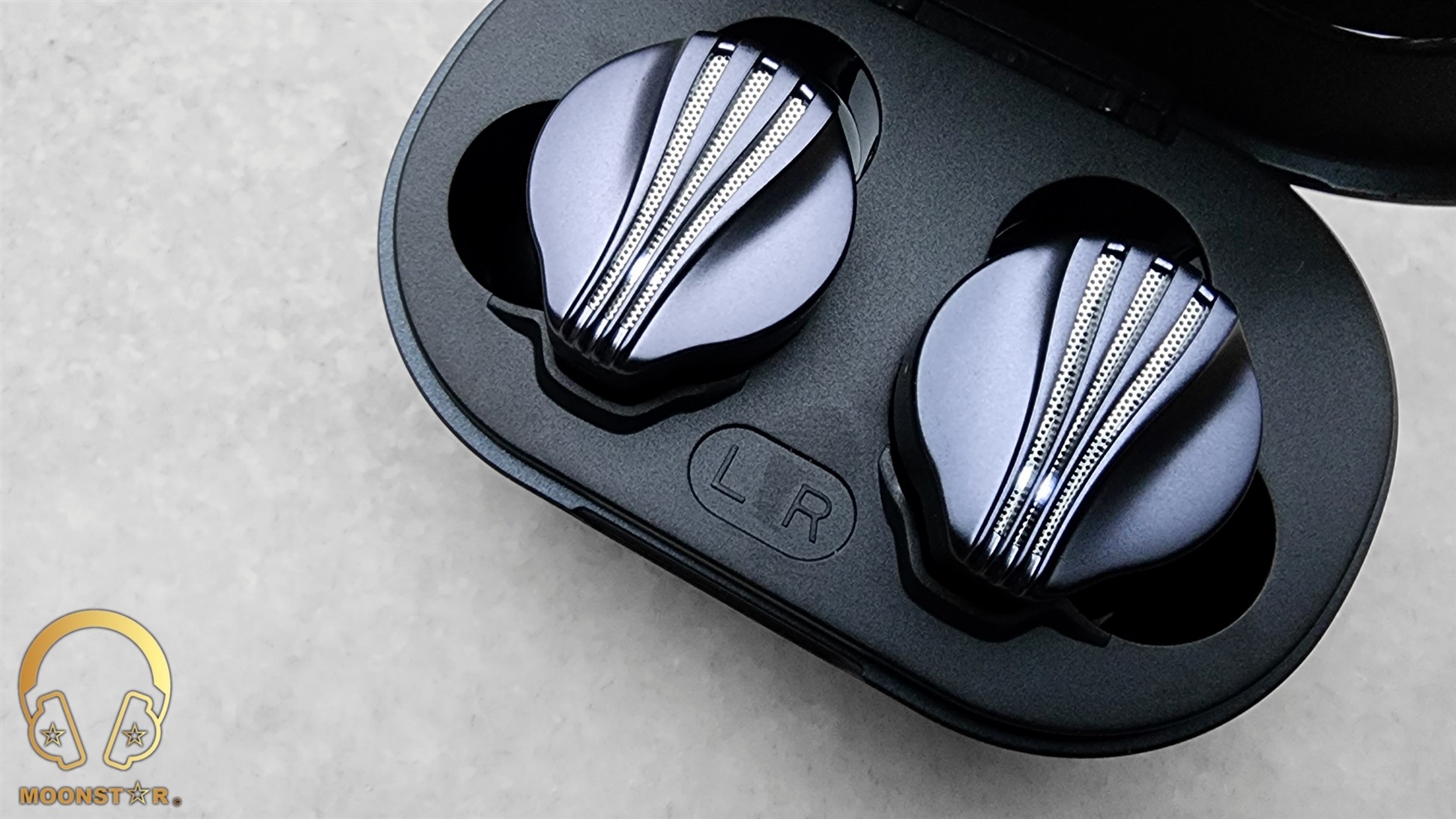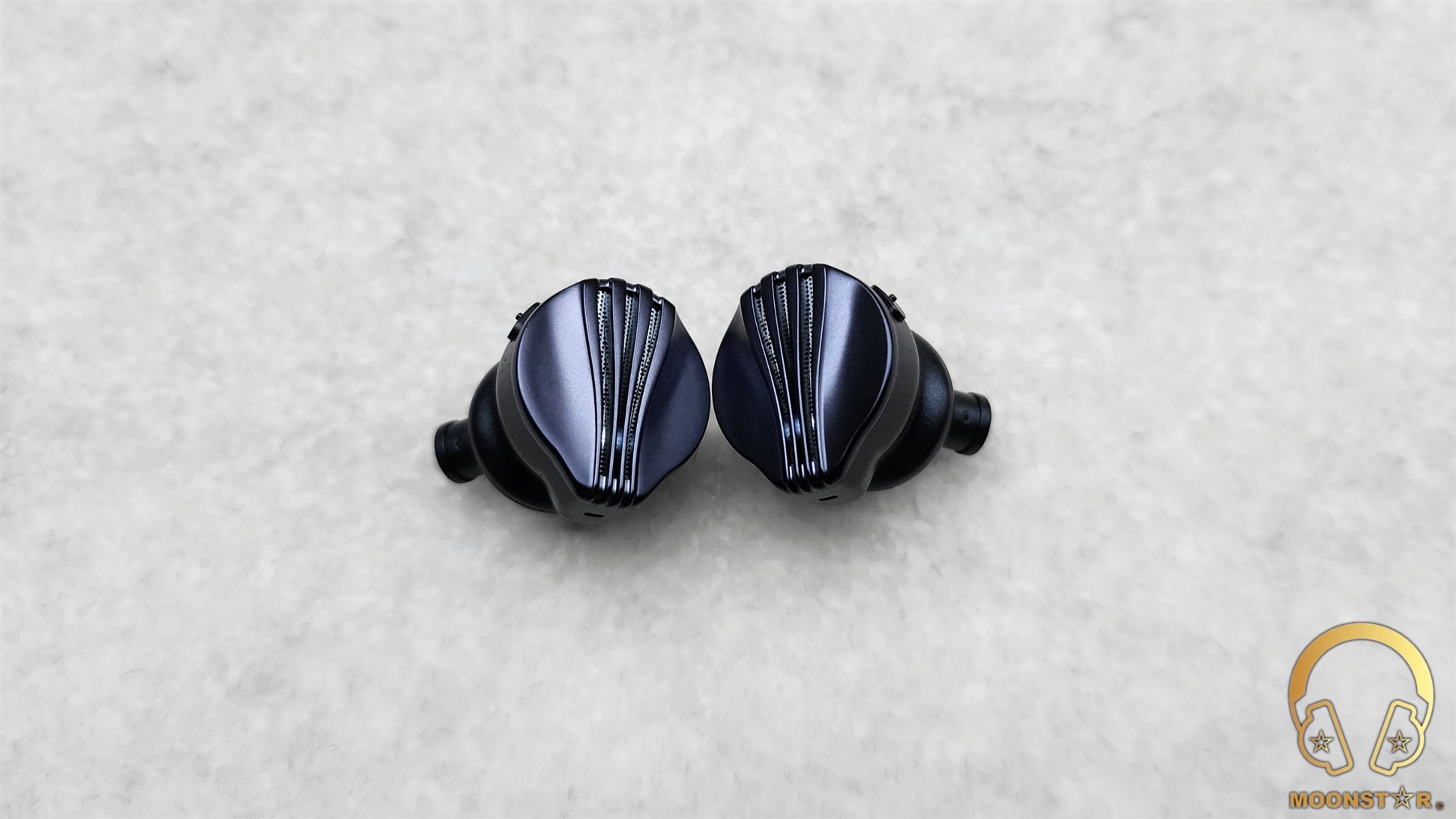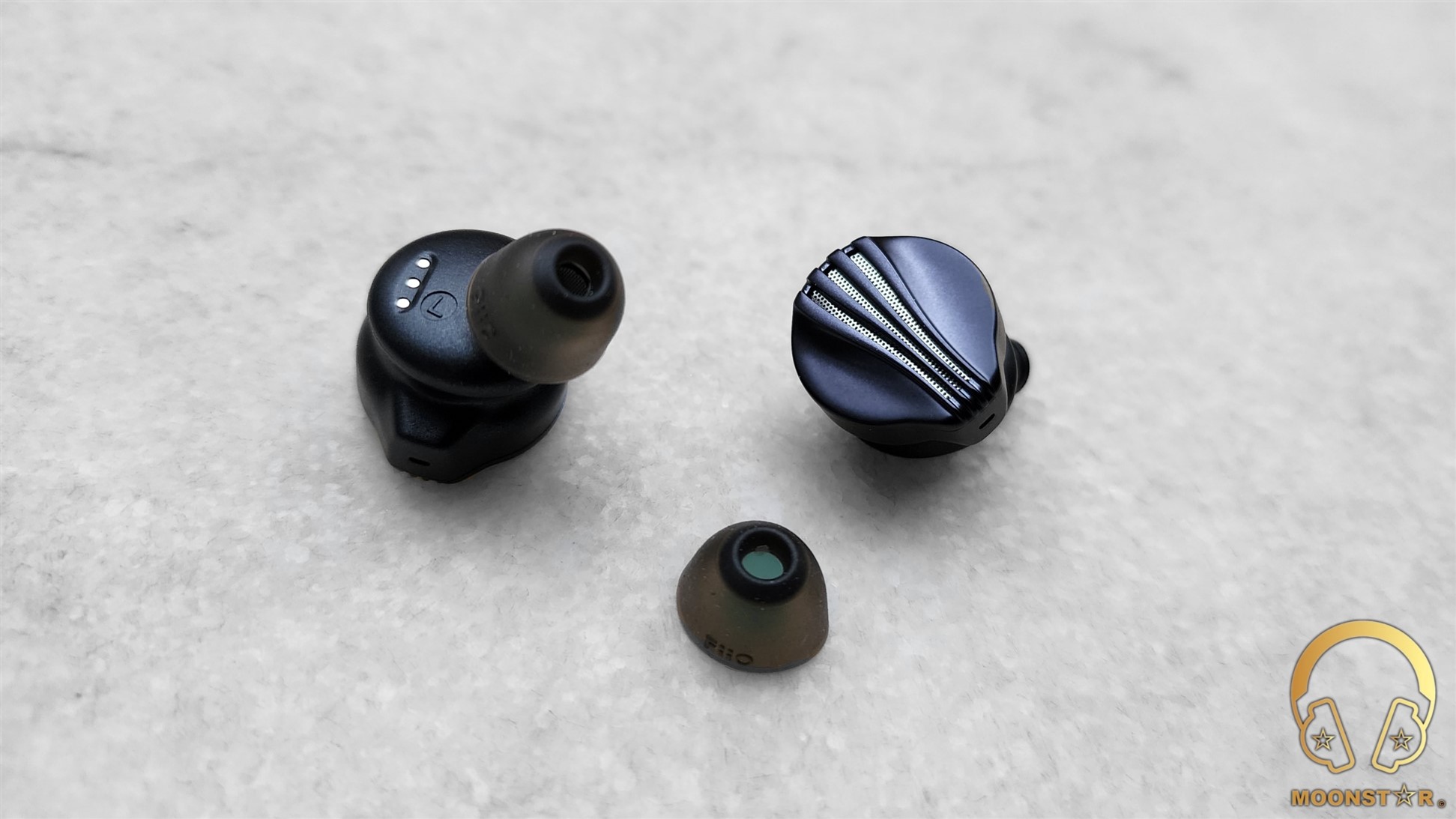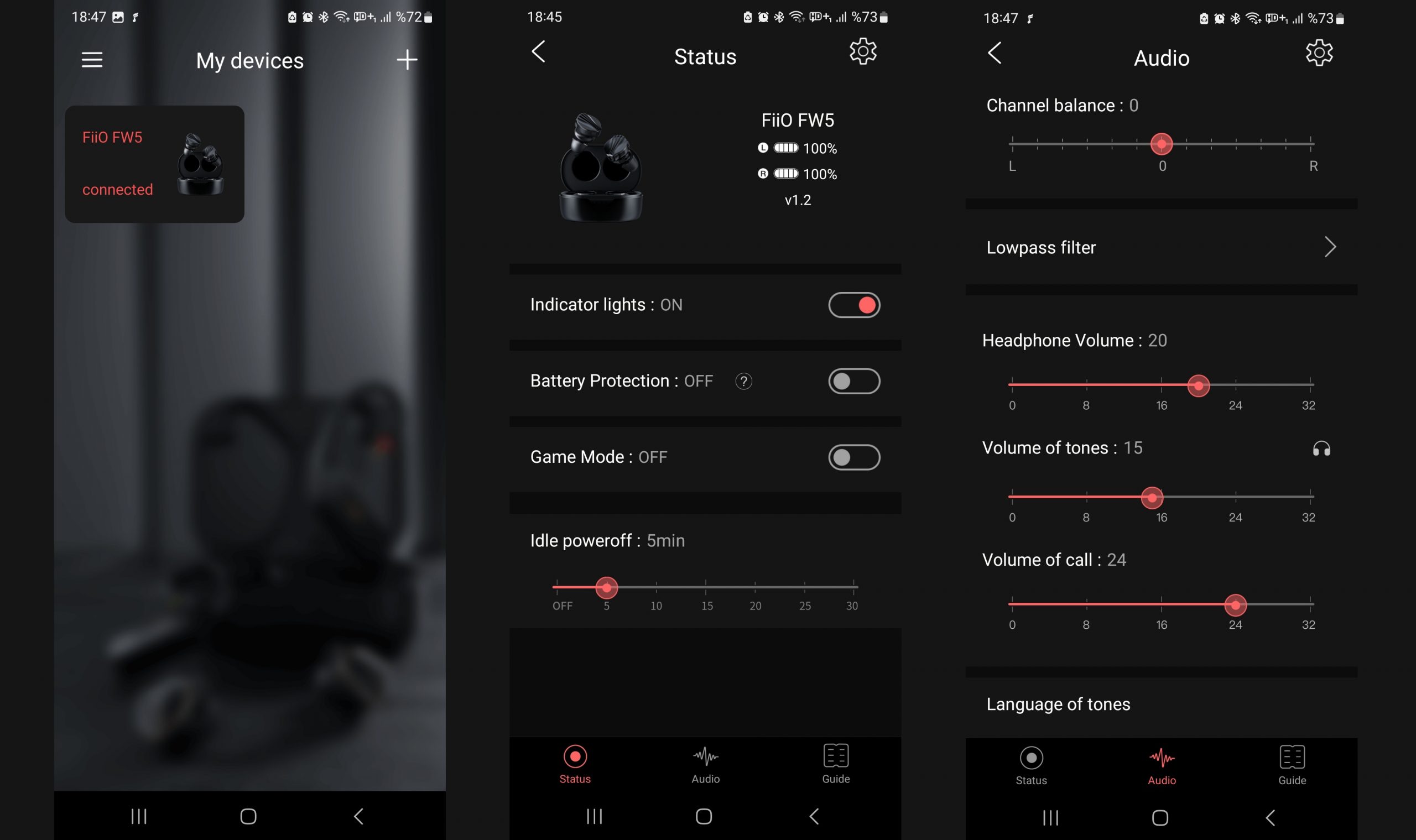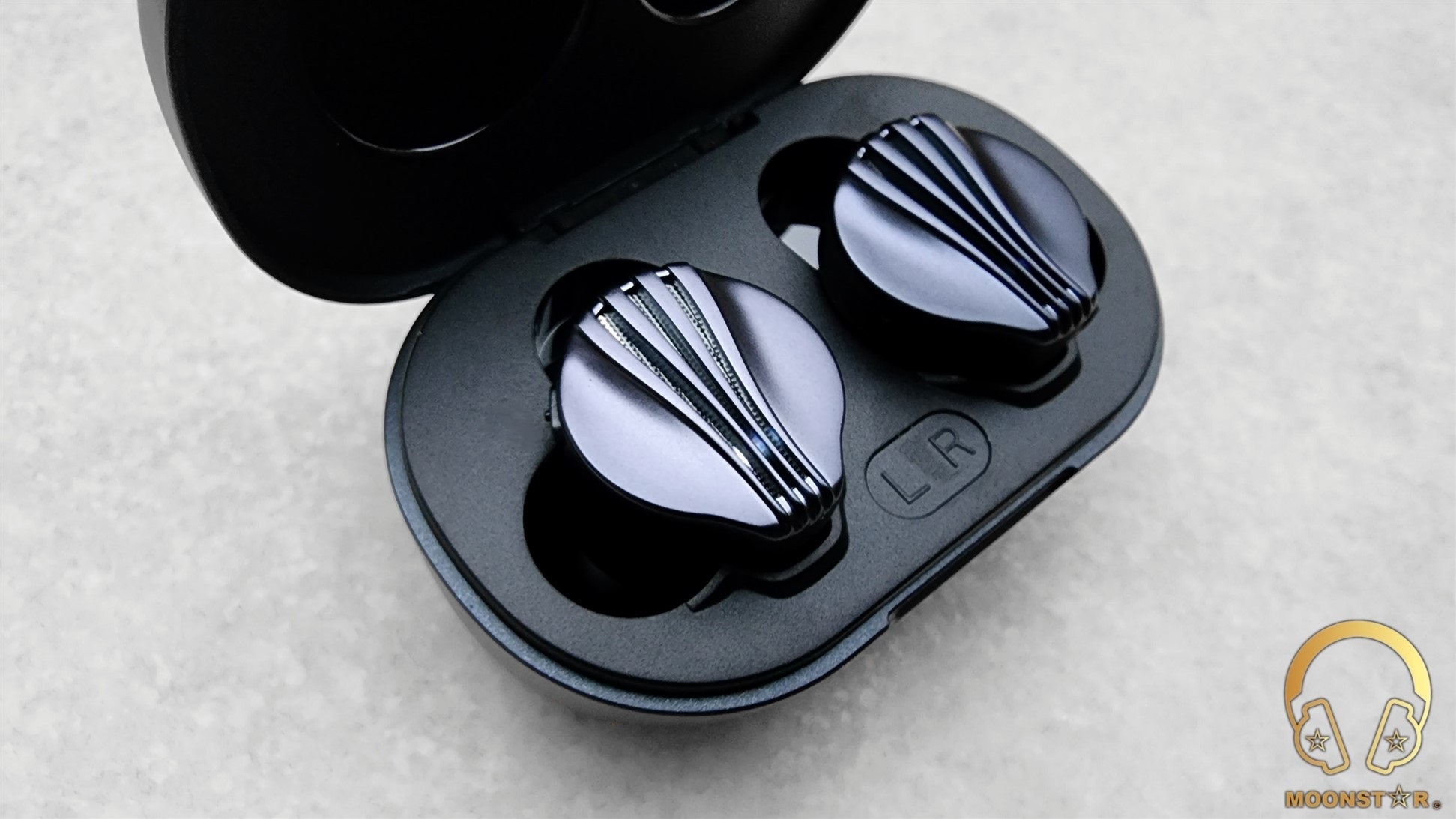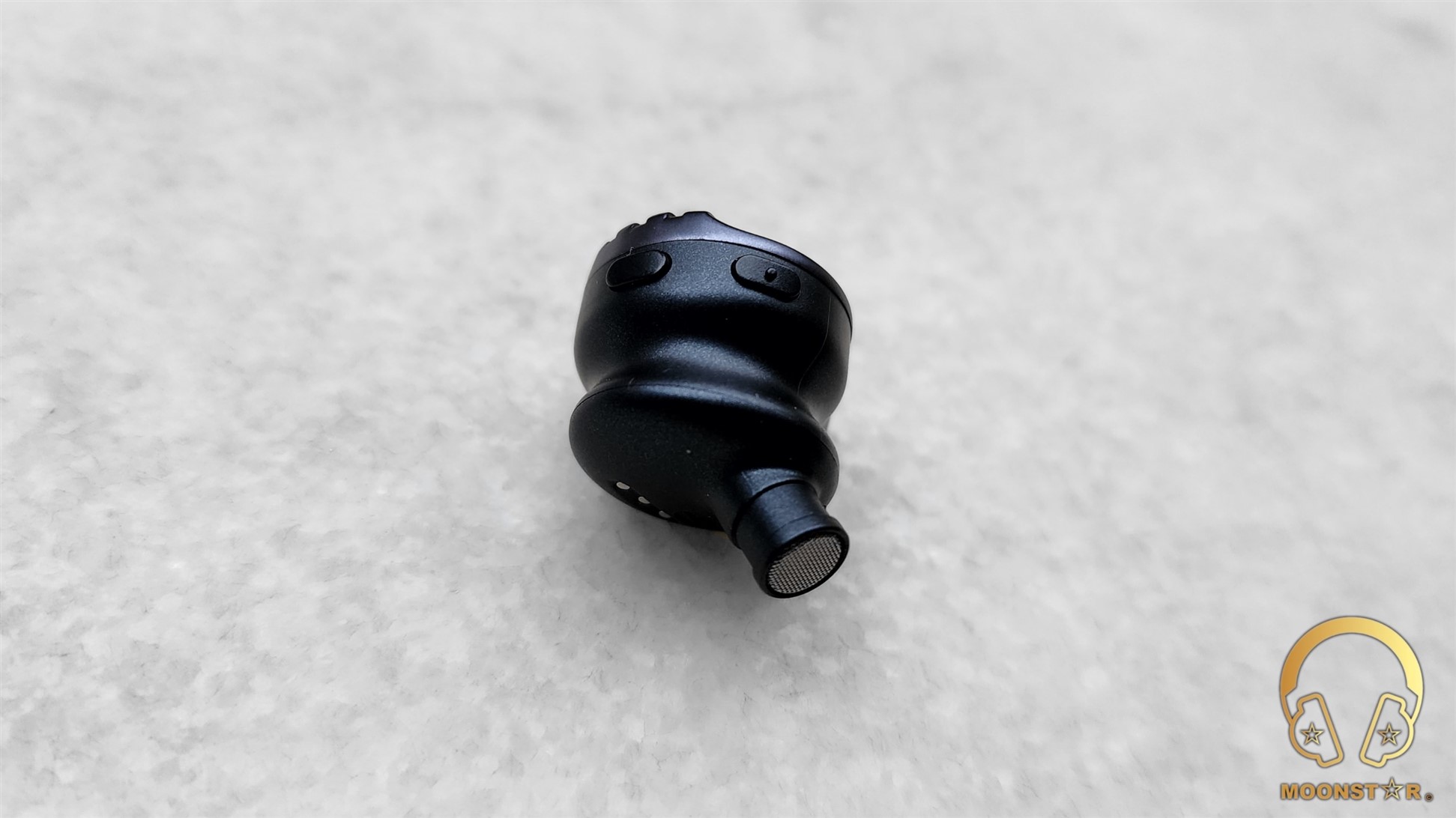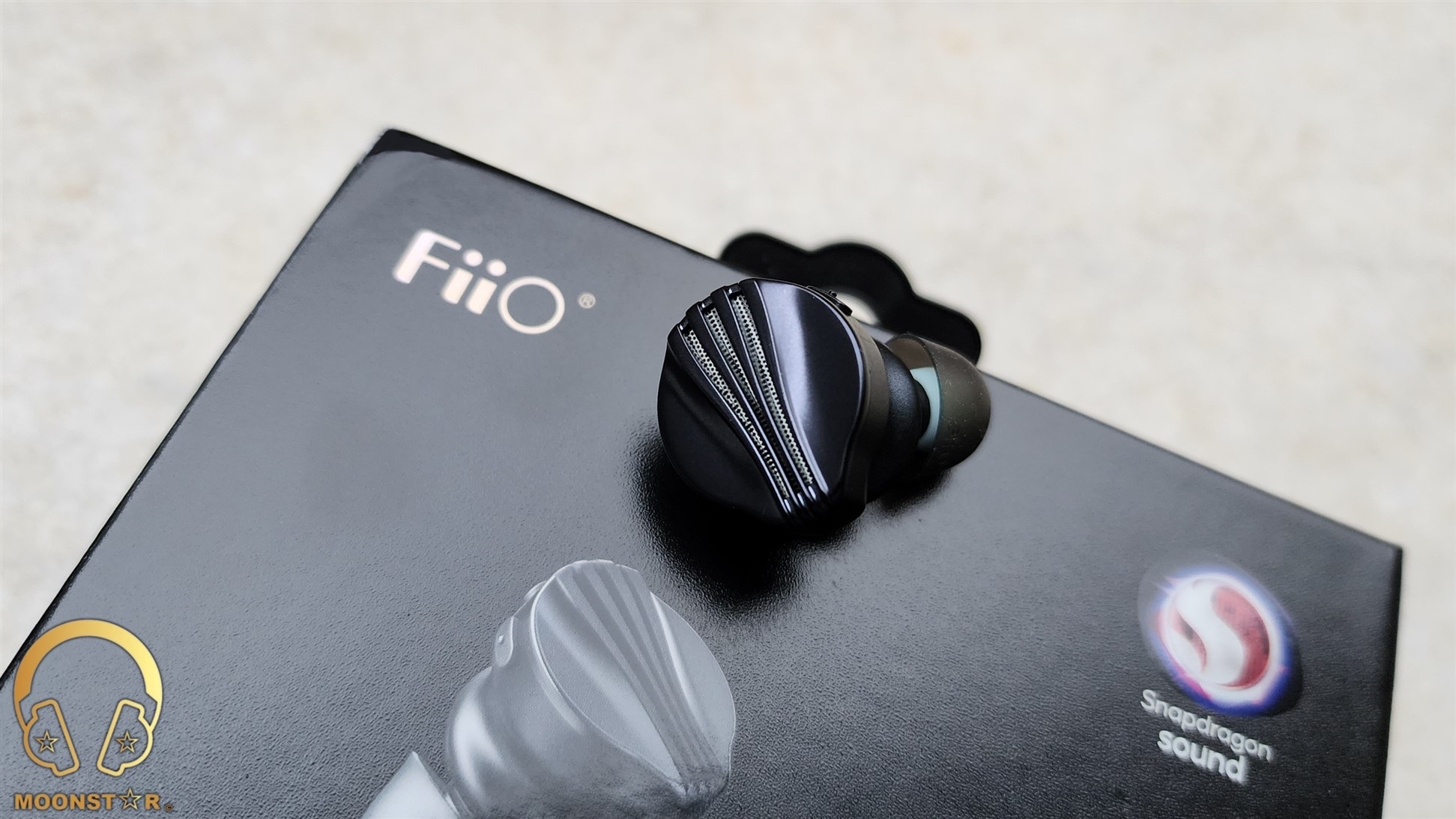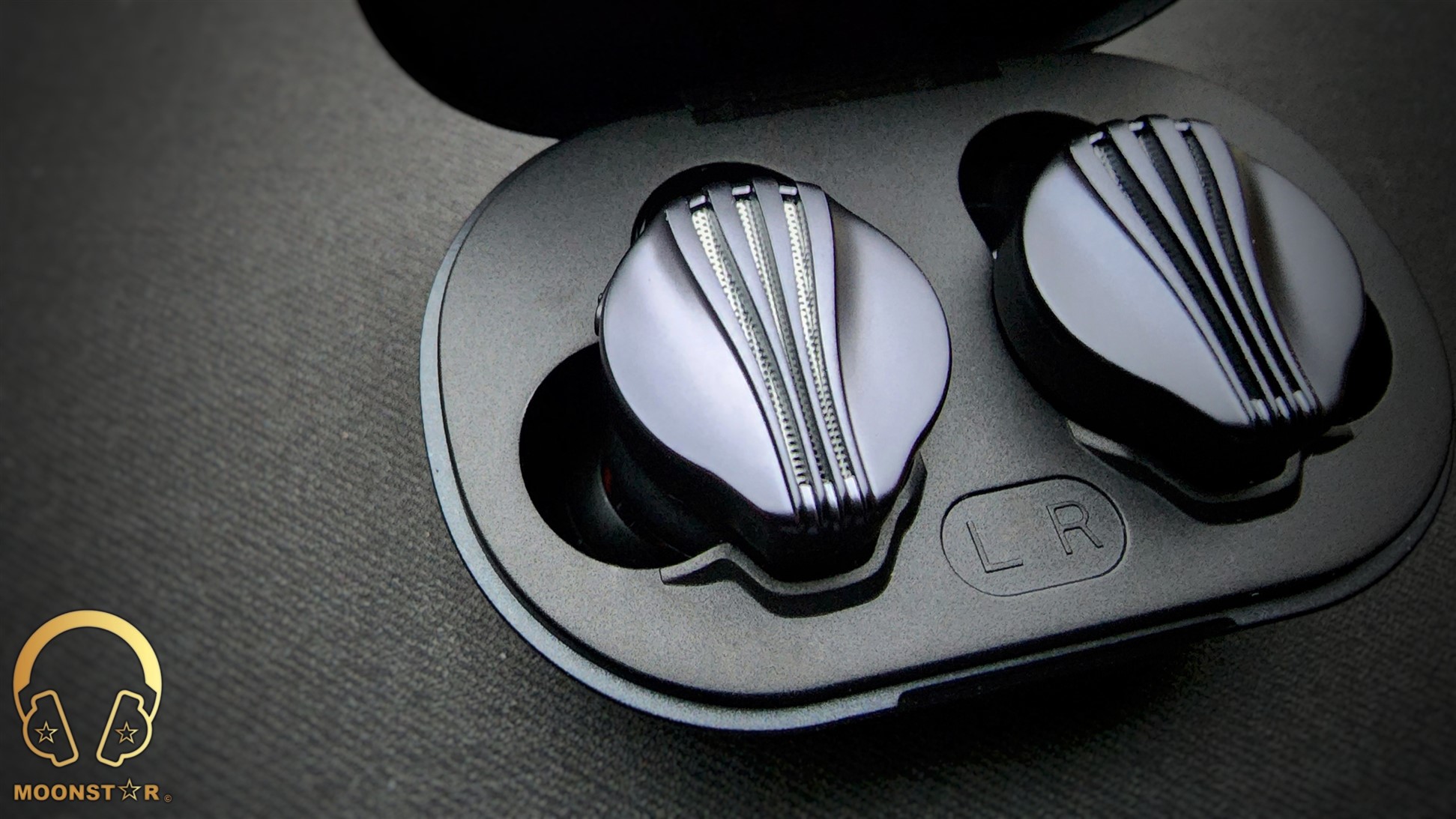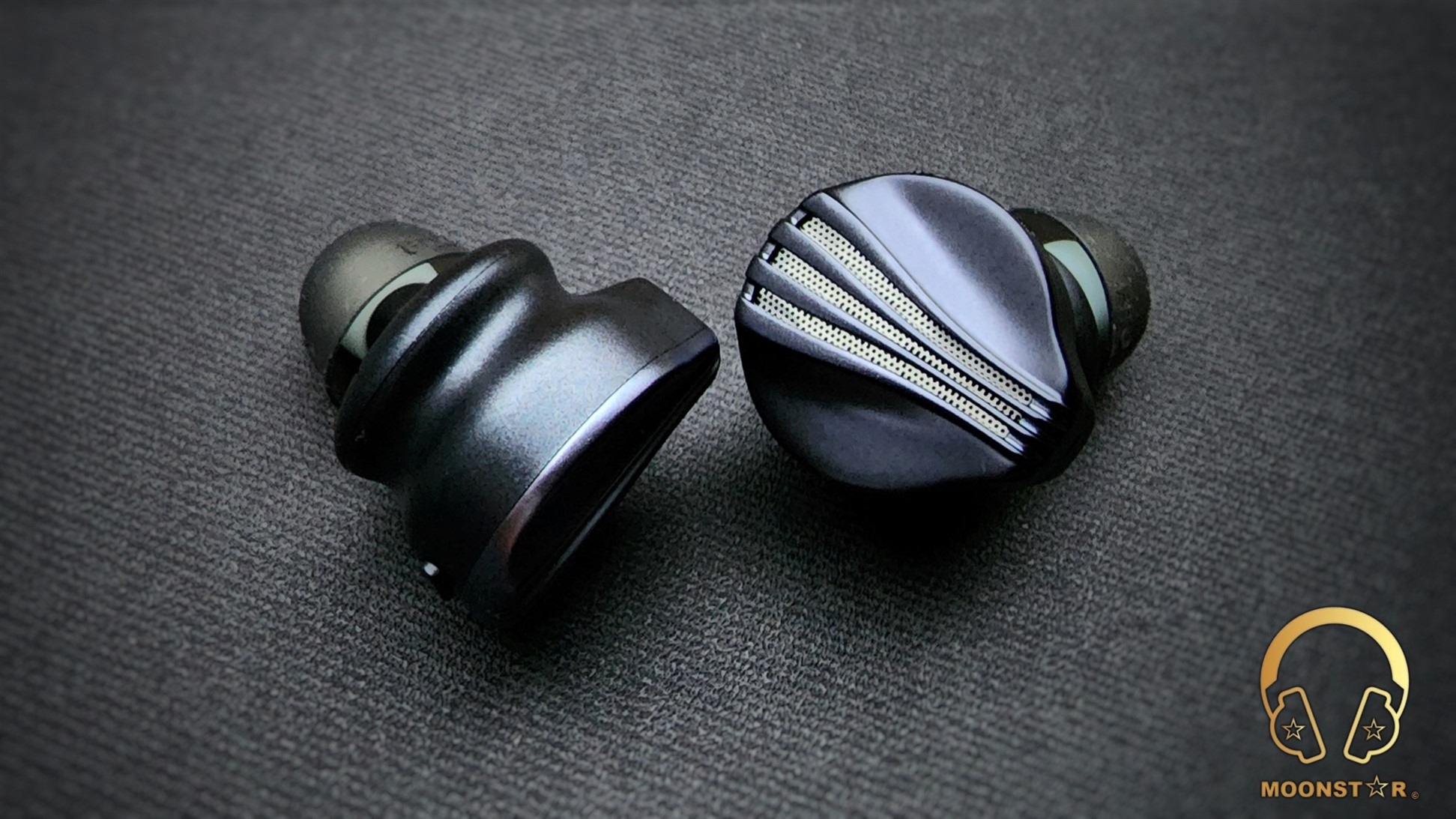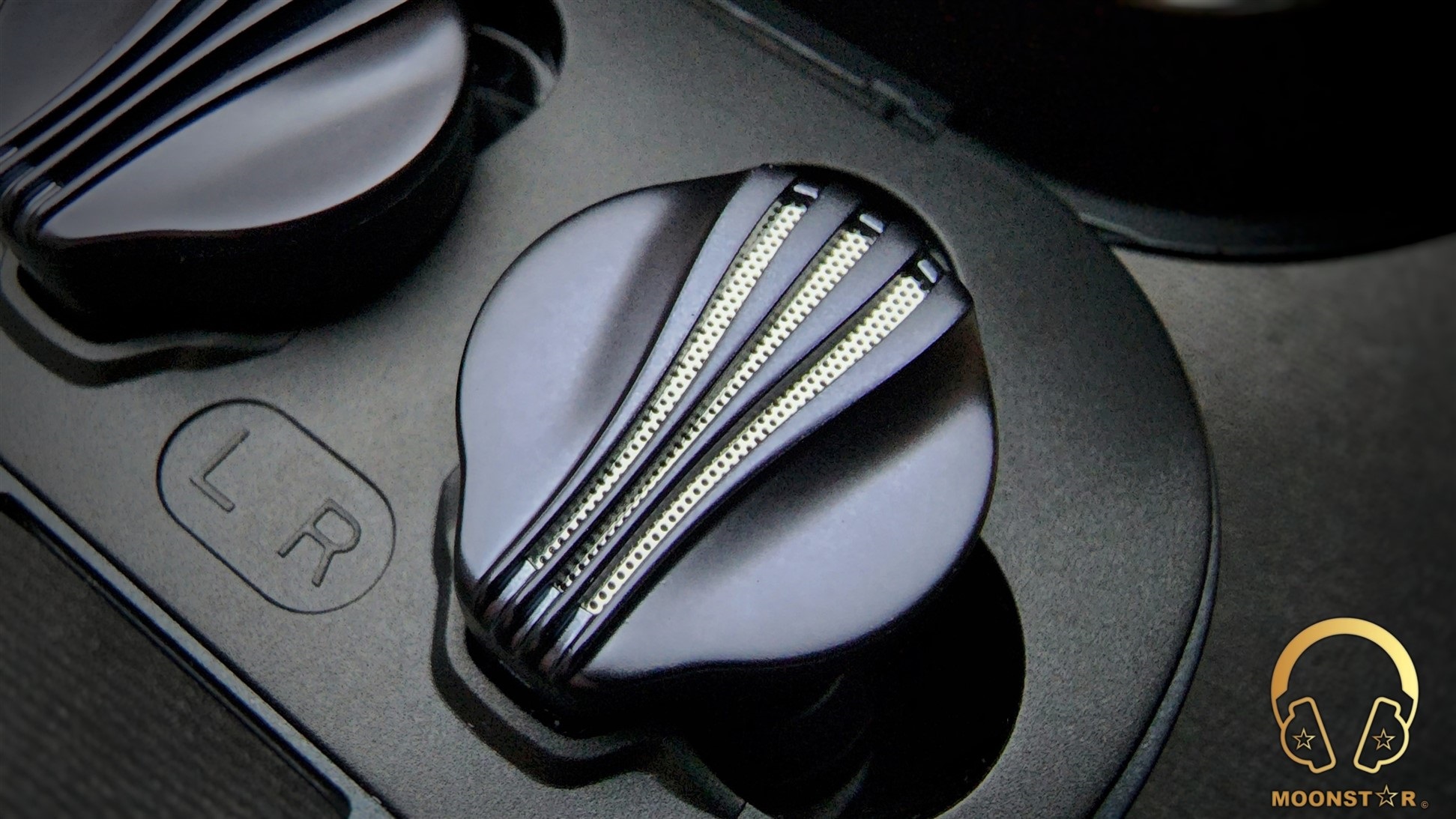Recently, I managed to complete my dream portable head-fi setup, consisting of an excellent music player (
M6U), a nice pair of earbuds (
FF5), and
excellent IEMs. The whole setup can be packed neatly in my briefcase and follow me everywhere.
I must have spent much time listening to this incredible setup, right?
Not quite. Most of my listening in the last few weeks was done with a pair of True Wireless Stereo (TWS) IEMs from Fiio. And no, it was not just for writing this review.
Let’s talk about Fiio FW5.
Forewords
- This review is based on a review sample from Fiio (Thank you!). I have no affiliation with or financial interest in Fiio. FW5 retails for around AUD $250.
- You should treat this review as subjective impressions of an audio geek rather than an “objective truth” about the IEM. Your experience with any IEM would change depending on your DAC/AMP, music library, ear tips, and listening volume.
- I believe that great IEMs are the ones that can achieve multiple difficult things simultaneously: (1) high resolution (elements of a mix are crisp, easy to follow and full of texture), (2) 3D soundstage with a strong sense of layering and depth, (3) bold and natural bass, (4) natural timbre and balanced tonality that can work with any genre of music.
- I rate IEMs on the scale from 1 (poor) to 5 (outstanding). The scale centres around 3, indicating “average”, “adequate”, or “acceptable” performance. Scores are assigned by A/B tests against benchmark IEMs representing how each score band sounds.
- Ranking list and measurement database can be found on my IEM review blog.
Specs
- Driver: 1DD + 2BA
- Connector Type: Bluetooth
- DAC: 2 x AK4332
- Impedance: Unknown
- Sensitivity: Unknown
- Water resistance: IPX4
What is TWS anyway?
No, I’m not asking a profound question. I had an epiphany when wrapping up this review, so I wish to share it with you.
We all know that TWS are Bluetooth IEMs that do not rely on any wire to connect with each other and a source device, such as your phone.
So which wire, in particular, was removed by TWS?
I have always thought the removed wire is the IEM cable (you know, the copper or silver strings that divide this head-fi hobby into “believers” and “objectivists” camps). However, as I hold the FW5 in my hands, it suddenly dawns on me that it is not the electrical cable that was chopped off.
It is the digital cable (e.g., USB) connecting your phone with your audio chain, including DAC, amplifier, IEM cable, and IEMs. When you start music on your phone, the 1s and 0s are transmitted wirelessly via Bluetooth (rather than a USB cable) to the DAC chip within each earpiece. The DAC chips then transform the 1s and 0s into electrical signals. The built-in amplifiers make the signals larger to drive the speakers (drivers), delivering sound to your ears. Bluetooth codecs such as AAC and LDAC, then, can be considered the “quality” of the digital cable. One day, when Bluetooth can transmit as fast and as many 1s and 0s as USB cables, we will have wireless systems that behave exactly like wired setups.
In other words, when you hold a pair of TWS in your palm, you are holding a full-fledged portable setup, not just two earpieces with their wires chopped off. This, my friends, is an impressive feat of engineering (and perhaps why it has been so tricky for traditional IEM manufacturers to make decent TWS).
In the box
Fiio FW5 is a midrange entry (number 5 in the name) in the main product lines of Fiio (FW - Fiio Wireless). The packaging reflects this position. If you have seen any Fiio product, then you know the drill: thick cardboard box with holographic prints and logos, magnetic flaps, two layers of custom foam inserts holding the goodies, and an abundance of accessories.
FW5 comes with a nice USB-C cable, two cleaning tools, and two sets of ear tips.
Your choices of ear tips include the classic “balanced” silicone tips and the newly released HS18 tips. They change the sound and comfort noticeably, so I recommend trying them all. I personally settled for a pair of medium HS18 tips.
Let’s talk about the earpieces.
At a glance, it’s immediately apparent that Fiio draws inspiration from their iconic FD5 and FD7. According to Fiio,
these IEMs are semi-open even though they have IPX4 water resistance. I can confirm that FW5 has a large and open soundstage, just like the FD and JD series IEMs.
Luckily,
the rest of the earpieces is lightweight plastic rather than stainless steel, like FD5 and FD7. The part touching your ears has the same shape as the Apple EarPods, allowing the earpieces to lock into place against the concha of your ears. Instead of a simple opening like the EarPods, FW5 terminates with a medium-sized nozzle placed at an angle. By twisting the earpieces back and forth, you can angle the nozzle just right against your ear canal for a comfortable and secure fit.
There are two buttons on each earpiece, bringing to a total of four buttons. These can adjust the volume, control playback, accept phone calls, and invoke voice assistants.
I have a bone to pick with Fiio regarding the volume control. Simply put,
the volume buttons are too insensitive. At first, I thought the volume control did not work due to some compatibility issues. And then, I realised that I needed to tap and hold the volume button a bit for the change to register, but not too long since FW5 would recognise a song skip request.
It should be noted that FW5 has independent volume control.It means that the volume buttons control how much FW5 amplifies the music. The system volume, such as on your phone, determines how loud the source music is for FW5 to amplify. Due to the issues with the volume buttons, I keep FW5’s internal volume at around 75% and use the phone to control the volume.
Let’s talk about the case. It is pretty simple. Some would even say it is cheap looking and feeling. I don’t mind, though I have complaints about the case design. Firstly,
it is too thick to store comfortably in my trouser pocket (“is it an FW5 in your pocket, or are you happy to see me”). Secondly, I mistakenly kept trying to pry open the case from the hinge side due to the symmetric design. With the AirPods Pro, at least I can feel the coldness of the metal hinge in order to orient myself.
Software and connectivity
FW5 can be controlled by the same Fiio control application used for BTR5, BTR7, and other Fiio Bluetooth devices. The app is a bit clunky to use, but at least it has parametric EQ. As far as I know, this EQ profile is stored within the FW5, meaning EQ works with any source device. I consider this feature a big plus.
Within the app, you can also turn on “game mode” to reduce latency. You can also prevent FW5 from being fully charged to increase the longevity of the batteries (yes, batteries: one in each earpiece and a larger one in the case).
The Bluetooth connectivity of FW5 is quite decent. I can leave my iPhone in the living room when doing housework in the kitchen. I can put my phone in my pocket without worrying about arbitrary cut-offs that plague my BTR5 2019. However, I have seen complaints about poor Bluetooth reception. Because my unit is perfectly fine, we can conclude that the issue is not systemic. If you have connectivity issues, you should discuss them with Fiio for a solution.
Usability
FW5 works as expected. When I open the lid, the earpieces connect. The earpieces disconnect when I put the back and close the cover. The TWS plays video without noticeable delays. It records voice with the same quality as the built-in microphone of my phone. It isolates as well as any semi-open IEM.
There are some hiccups now and then. For instance, sometimes my phone connects to only one earpiece. Sometimes, the sound is 1 or 2 seconds behind YouTube videos. Sometimes, the connection drops randomly for a fraction of a second, even though the phone is in my hands. These minor issues highlight the difficulty of achieving the spotless experience of AirPods. However, given how good these IEMs sound, I find these issues manageable.
There is no active noise cancellation, meaning when you are on a very loud bus, for instance, the music would be drowned out. In most situations, even on a busy street, passive isolation of FW5 is adequate.
How it sounds
Let’s do something different and totally “unfair” in this review, shall we?
I’ll pitch FW5 against full-fledge wired IEMs powered by a proper desktop setup, my K7 DAC/amp combo. Moreover, I’ll pair FW5 with my iPhone via AAC. This pairing is a handicap to FW5 because AAC generally prevents Bluetooth DAC/amp from offering full fidelity and soundstage. My reason is simple: I want to see how a practical everyday carry setup competes against a purposely built setup for audio enjoyment.
Instead of “high brow” audiophile lossless recordings, let’s stick to the casual listening theme and use available music on YouTube. My belief is that if an audio chain is good, it should make everything you listen to sound good.
Noted that I use HS18 ear tips for these comparisons. These tips reduce the midbass of HS18 noticeably, giving a “tighter” bass response. Other tips can produce noticeably different impressions.
Tonality and Timbre: 4/5 - Good
Frequency response of FW5 against Blessing 2 and the Harman in-ear target. Measurements were done with an IEC-711-compliant coupler and might only be compared with other measurements from this same coupler. Visit my graph database for more comparisons.
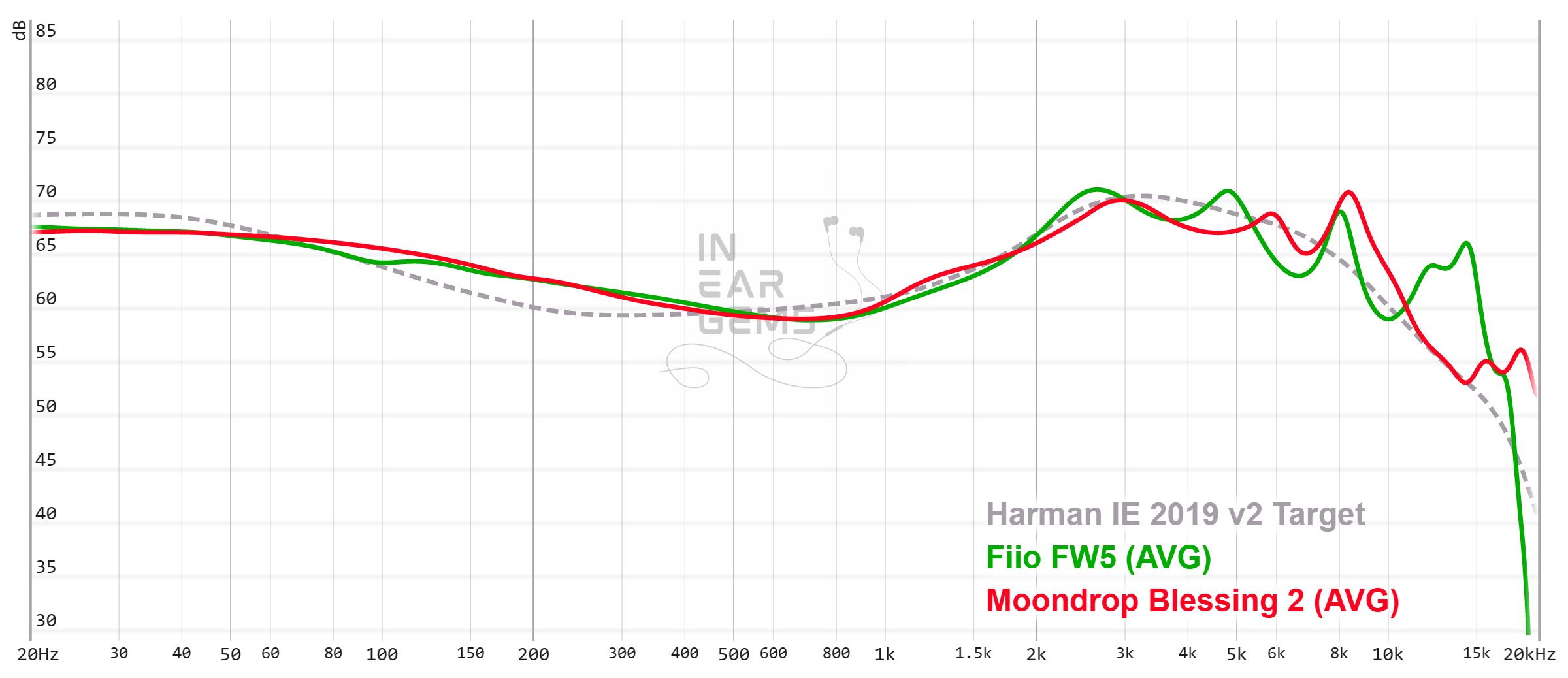
Tonality or “tuning” is where objectivity and subjectivity meet. Objectivity exists in the squiggly lines above, called Frequency Response (FR) graphs. They are created by sweeping a signal from 20Hz to 20kHz and measuring the corresponding loudness coming from an IEM. Unless a human operator deliberately tampers with the microphone or the data, FR does not care about the price or prestige of an IEM and, therefore, is “objective.”
However, human listeners are not microphones. Our ears and brain interpret the sound and decide whether it is “enjoyable.” It is also beneficial to remember that when you play a note on a musical instrument, multiple sounds (fundamental and harmonic) appear simultaneously and mix together. Achieving a life-like balance between frequencies and adding a tasteful amount of imbalance (“colouring the sound”) is the hallmark of an excellent tonality.
Enough with the theory. How does FW5 sound?
Classic Fiio’s single dynamic driver sound with a twist.
Let’s talk about the classic dynamic driver sound. Simply put, it’s a
Harman-inspired sound with extra bass punch and warmth.Besides small wiggles between 2.5kHz and 10kHz, FW5 generally traces the Harman target with only one significant deviation: extra energy from 150Hz (the bass “punch” region) to around 3-400Hz (the “warmth” or “note thickness” region).
As FW5 traces Harman’s target decently well, it side-steps most tonality and timbre problems. I can try to give you some concrete indicators from recordings, but that wouldn’t add anything to the point that FW5 sounds correct. Vocals, bands, orchestras, electronic instruments.
Everything sounds natural and realistic with an extra dose of warmth (some may say “musical”). The warmth is not overdone to the point of muddying the midrange.
The deviation of FW5 from the target in the lower frequencies removes that sense of detached bass and colder tonality of some IEMs, such as Monarch MkII. Instead, FW5 has a punchy bass and a vibrant midrange. It means you can hear the “boom boom” of the bass, not just the low-pitched “brrrr” rumble. Vocals and instruments have more bloom, warmth, and richness without being too muddy or unnatural.
Does that mean FW5 has “bass bleed”? In some sense, yes, because some vocals and instruments do feel a bit “denser” than in real life. But I would offer two points for consideration. Firstly, at no point does the midrange become muddy or masked by the “boom boom” from the bass. Secondly, FW5 matches Moondrop Blessing 2 exactly, measurement-wise, from 20Hz to 1kHz. Does Blessing 2 has “bass bleed”?
Let’s talk about the “twist.” I want to direct your attention to the peak in the air region, starting from 10kHz, where FW5’s BA drivers take over from the dynamic driver.
Fans of the TIA technology from 64 Audio might recognise this peak and its benefits: highlighting micro-details such as room reverbs, enlarging the soundstage and giving it a “3D” illusion.
All of these benefits are here with FW5, with
an unfortunate drawback: BA timbre. Some high notes can sound “scratchy” or “grainy”. It only happens sometimes. However, when a high-pitched note falls on the right part of the spectrum, you would scratch your head and say, “oh, that’s … odd?”
With all these praises, you would think I’m thoroughly pleased with FW5’s tonality. Oh no, my friends.
I do have some bones to pick with Fiio: the “cat ear” tuning. The twin peaks at 2.5kHz and 5kHz, in particular.
What’s so wrong with this tuning?
It’s helpful to consider a visual example by thinking of a photo. You can see the edges of various shapes and objects, such as houses, cars, and people. The peaks at 2.5kHz and 5kHz act like sharpening filters for photos, which make all the edges more contrasty and noticeable, creating the illusion of “sharpness” or “resolution.” Abusing sharpening filters makes the images harsh, grainy, and unpleasant. It’s the same situation in the audio world. The “cat ear” tuning sharpens the initial attacks of vocals, string plucks, and stick impacts on the drums. When overused, the sharpening can lead to harshness and masking of fine details in music, some of which are carried in the 3-4kHz region.
Not to say that FW5 sounds artificially sharpened or harsh. In fact, the amount of “cat ear” was just to the point of giving FW5 some highlights and sparkles.
However, FW5 lacks the smoothness and natural sense of detail in the midrange that I associate with “excellent” or “refined” tuning. For instance, when I listen to Survivor’s
Eye of The Tiger, I can hear all the instruments and vocals clearly due to their crisp “edge”. Still, some fine details within the midrange are masked. I said “masked” because I can still hear textures in the voice and instruments, but I have to look for them or turn up the volume.
Conclusion? I consider FW5’s tuning as 4/5 - Good. I like the fact that it does not have tonal problems. I like the TIA-inspired treble tuning. I’m disappointed by the cat ears. If anything, the cat ears make FW5 sound a bit generic.
Resolution, Detail, Separation: 4/5 - Good
Resolution is a fascinating subject due to the difficulty of pinning what it really is. To me, “resolution” can be separated into “macro” and “micro” levels. The “macro resolution” is synonymous with instrument separation. In general, if note attacks are very crisp and precise, musical instruments in a song would be distinctive even when they overlap on the soundstage. The “micro resolution” dictates how many details you can hear at the note tails. Many IEMs are good at macro- but mediocre at micro-resolution. A few are vice versa.
FW5 is proficient at macro-resolution, meaning it renders complex and dense recordings such as
One-winged Angel with a high degree of clarity, crispness and separation. All instruments have well-defined “edges”, making it easy for me to identify and follow them. Of course, a part of this advantage comes from the large soundstage that pushes instruments further from each other. However, FW5 is no slouch, even when instruments overlap in the mix. For instance, in the section from around 1:00 of One-winged Angel, when the whole orchestra plays together, I can still distinguish the instruments and hear the clarinets and flutes through the dense string section. When the choir comes in at around 1:22, I can hear voices, not just a blob of vocals.
FW5’s micro-resolution, unfortunately, is not as good as its macro-resolution. Let’s take
Rasputin cover by Aurora as an example. FW5 does an outstanding job rendering elements of the mix, particularly the beautiful backing vocal. It’s easy to pinpoint and follow the backing vocal, a feat achieved by only some wired IEMs. However, I always feel that a small layer of detail and texture, the “breaths” in Aurora’s voice, is not highlighted enough. It is there, I can hear it if I pay attention, but it is masked by the “starting edge” of musical notes.
Alright, so FW5’s resolution is good. But how good? Let’s make some comparisons.
Firstly, let’s compare with Moondrop Aria (3/5 - Average), driven by a desktop rig. With the One-winged Angel, at first glance (listen), I said, “they are exactly the same.” But then, as the music gets denser, the Aria starts to fall behind with its slightly woolly fuzzy presentation. The difference reveals itself the clearest with the choir. The best way I can explain is to think of Aria as a 720p screen, whilst FW5 is a 1080p screen. At a glance, they are equally sharp. But if you spend more than a minute with them, you start to see the difference.
Secondly, let’s compare with Moondrop Blessing 2 (4/5 - Good), again, driven by a desktop rig. Now, we are talking! With One-winged Angel, I hear a nearly identical tonal balance. FW5 sounds slightly crisper and more separated. On the other hand, Blessing 2 does have a slight edge in micro-detail. For instance, there is a small detail of key pressing on the flute within the first 30 seconds of the track. Blessing 2 highlights this detail, whilst FW5 takes effort to detect.
The Rasputin cover by Aurora further highlights the difference between FW5 and Blessing 2. The TWS has a clear edge in macro-resolution, evidenced by the clarity of the backing vocal. Blessing 2 shows a clear advantage in micro-resolution, in the texture and breathiness of the vocals, right from the first words by Aurora.
In summary, I consider FW5’s resolution as 4/5 - Good. Even in a very unfavourable testing condition, the TWS traded blows with the venerable Blessing 2, the flag bearer of 4/5 resolution.
Percussion and Bass: 4/5 - Good
Percussion and bass rendering reflect how well the tuning and technical performance of an IEM work together to recreate realistic sound of drum sets and bass instruments. Good drum hits have a crisp attack (controlled by frequencies from 4kHz to 6kHz), full body (midbass frequencies around 200Hz), and physical sensation (sub-bass frequencies around 50Hz). Good technical performance (“fast” driver) ensures that bass notes can be loud yet detailed. IEMs that cannot control bass very well tend to reduce the bass’ loudness to prevent muddiness.
FW5’s bass carries the typical characteristics of Fiio dynamic driver IEMs, meaning abundant but manageable in quantity. In fact, its bass shelf is identical to that of Moondrop Blessing 2. There is a strong sense of sub-bass, meaning there is a sensation of physical rumble and power behind drum hits. The midbass is not neglected, so you would hear “boom boom” in your music rather than only feeling the rumble.
The bass quality is where FW5 pulls ahead of Blessing 2. Let’s take
Eye of the Tiger by Survivor as an example. The difference between FW5 and Blessing 2 is immediately noticeable from 0:30 when both the kicks and the bass guitar started. The kicks have satisfying THUMPs. The start of kicks, when the beater hits the drum, is snappy rather than slightly soft and “slow”, like Blessing 2.
The most interesting difference, to me, is the bass guitar. Simply put, I have never been able to hear and distinguish the bass from the kick when I use my Andromeda, Blessing 2, and a few other “neutral” IEMs without mid-bass. But with FW5, I can detect the bass guitar and recognise the notes it plays. A good example is around 0:50.
On the other side of the spectrum, the cymbals and hi-hats cut through the mix cleanly. Perhaps a little bit too hot for me if I always listen to cymbals and hi-hats. I don’t, so a bit of sizzle is alright.
Conclusion? I would say FW5’s bass and percussion rendering is 4/5 - Good. Totally proper, totally correct, totally respectable. One step above the usual textureless woofers out there. But at the same time,
it lacks a “special sauce” that makes me want to write long paragraphs to describe it. It’s simply “good.”
Stereo Imaging (Soundstage): 5/5 - Excellent
Stereo imaging or “soundstage” is a psychoacoustic illusion that different recording elements appear at various locations inside and around your head. Your brain creates based on the cues in the recording, which are enhanced or diminished by your IEMs, your DAC, and your amplifier. Some IEMs present a wide but flat soundstage. Some show a “3D” soundstage with layering, depth, and height. In rare cases, with some specific songs, some IEMs can trick you into thinking that the sound comes from the environment (a.k.a., “holographic”)
Open back design and TIA-like treble air. Unsurprisingly,
FW5 performs mightily in both soundstage size and imaging accuracy.
Let’s take Vivaldi’s Winter performed by the Early Music ensemble Voices of Music, as an example. The FW5 places me at the front-most seat or even the conductor podium.
The whole ensemble is spread around me, with a clear sense of depth and layering.For instance, the lute (guitar?) on the right side sounds closer to me than the cello at the back rather than on the same flat plane. When I closed my eyes and tried to forget that I was listening to a recording, I was somewhat convinced I was in a concert hall. (Somewhat. These are a nice pair of earphones, not a VR headset.)
Let’s compare it with Moondrop Blessing 2 (4/5 - Good). The venerable IEM can somewhat match the width of FW5’s soundstage. However, it is entirely outclassed by FW5’s depth and layering. For instance, FW5 renders the section from around 0:56 of Winter with the soloist standing closer to me. The orchestra forms a dome, further away and wrapping around the soloist. Blessing 2, on the other hand, puts everything on the same thin and dense plane. The illusion of being in a concert hall rarely appears with Blessing 2.
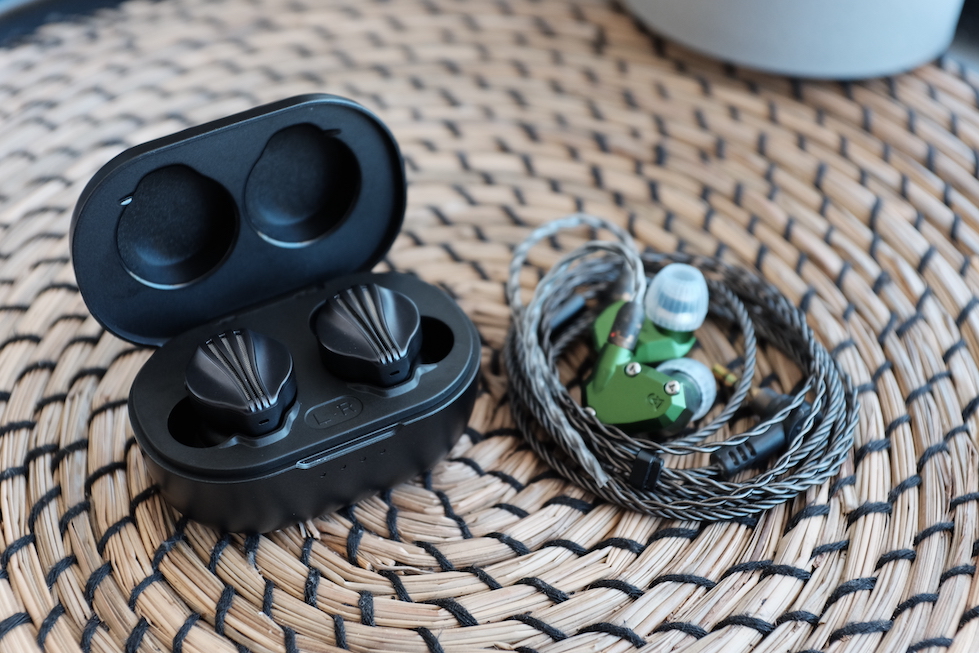
Let’s bring out the big gun, my Andromeda 2020 (5/5 - Excellent). The way Andromeda and FW5 place instruments on the soundstage are pretty similar. Both paint a 3D picture rather than a flat and wide soundstage. However, the Andromeda sounds more “real” due to its boomy and muddy tuning. For instance, cellos sound clean and clear with FW5 but boomy with Andromeda. Coincidentally, cellos don’t sound that clean in real life, at least at my local concert halls. So in some senses, Andromeda does a better job of tricking me into thinking I was in the hall. At the end of the day, I think it is a matter of preference. Both IEMs do a similar job at presenting a soundstage.
In conclusion, I rate FW5’s soundstage imaging 5/5 - Excellent. It does an outstanding job, not just “for the price” or “for a TWS.” It’s simply excellent.
Some Comparisons
In this section, I compare FW5 with the only other TWS in my collection: the mighty Apple AirPods Pro (APP). You can use my
ranking list to compare FW5 with others. Due to how I rank IEMs, if two IEMs score the same, they perform more or less similarly.
My APP is equipped with comply foam tips. I also have set up the personalised spatial audio feature. Let me elaborate a bit for readers unfamiliar with APP. These devices have Active Noise Cancellation (ANC), which relies on microphones and signal processing to mix a “negative copy” of the noises around you into your music to cancel out the noises. Doing so can introduce different degrees of degradation to the sound quality. Therefore, in this test, I disabled the ANC.
Another nice feature of the APP is spatial audio. No, it’s not just about playing Dolby Atmos content. AirPods Pro can apply signal processing directly to any audio stream to extend the soundstage. The latest software version of AirPods Pro introduces a personalised spatial audio mode, in which you can use an iPhone camera to make a 3D scan of your face and ears so that the APP can adapt itself to your personal HRTF function. Does it work? Sometimes. In my case, APP EQs a bit extra upper midrange in addition to cross-feeding and other audio tricks.
Let’s take One-winged Angel as the example again for comparison. Tuning-wise, APP feels “hollower” than FW5, possibly due to some dip around 1kHz to extend the soundstage size. This hollowness does get annoying after a while.
However, the most annoying issue of the APP, to me, is the merely average resolution that it shows. Regardless of whether digital signal processing tricks are on or off, APP does not sound very crisp and detailed. For instance, FW5 renders the choir as a collection of voices. APP renders the choir as a blob of vocal sounds. In other words, it sounds like an Aria or similar IEMs at the 3/5 resolution level. FW5, on the other hand, trades blow with good performers like Blessing 2.
How is the soundstage? APP with spatial audio can sound larger sometimes. In some tracks, APP can sound like I left speakers on in my room. However, APP can also sound hollow and unnatural. Meanwhile, FW5 consistently sounds large but never triggers the uncanny feeling of APP.
Conclusion? I’m not too fond of the APP. I use FW5 daily when I cannot carry my DAP and wired IEMs. Or when I watch a few YouTube videos or a show.
Conclusion
Is there much life left in the portable “audiophile” market? For fans like me and you, we would love to respond with a resounding “YES.”
However, many manufacturers see the writings on the wall.
If you have read the R&D stories of Fiio FW5, you can sense anxiety and pessimism. In some senses, Fiio’s worries are not totally unfounded from the perspective of a consumer product. The lack of LDAC is a contention point to some listeners (Though my A/B tests in this article show that even the inferior AAC codec did not have any issue). There were some reports of spotty Bluetooth connection. There are some usability hiccups, such as the insensitive volume buttons. The case could be thinner for improved pocketability.
However, looking at FW5 from an “audiophile” perspective shows a much more positive picture. Simply put, these are good-sounding IEMs. Tonality, though it could be further polished, is balanced and correct. The bass is taut and lively without overwhelming. The resolution is good. Soundstage imaging is top-notch. The value proposition of FW5 further heightens if we consider that this product replaces not just a pair of IEMs but also the dual-AKM DAC and amplifier sitting between your phones and the IEMs. If you are in situations where you can’t bring your DAP and wired IEM but want to keep the sweet, sweet head-fi sound quality, these FW5 are worth consideration.
Pros:
- Large, open, 3D soundstage
- Punchy but controlled bass and percussions
- Excellent instrument separation
- Tonally correct
- Stable connection
- Parametric EQ
Cons:
- Thick case
- Volume buttons borderline unusable
- Micro details are merely good
- Somewhat generic tuning due to the twin peaks at 2kHz and 5kHz
- No LDAC support (yet)
Updated: February 12, 2023















